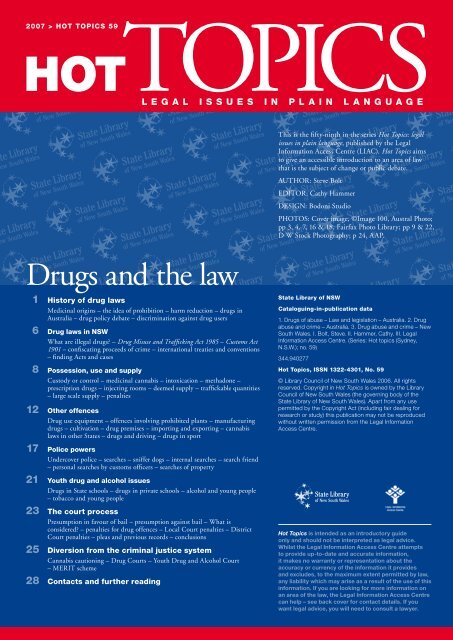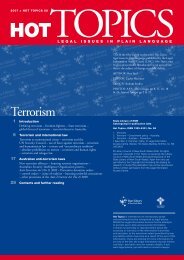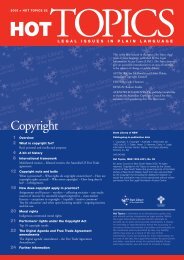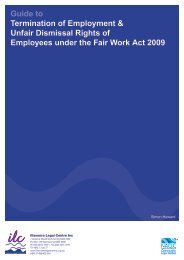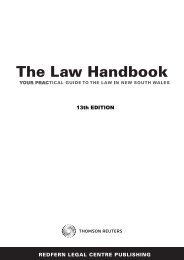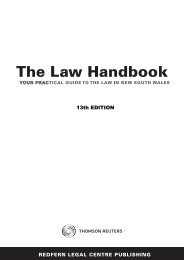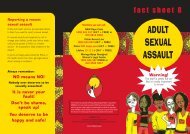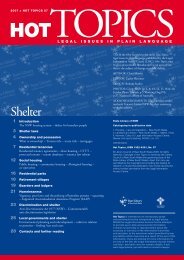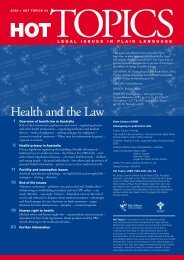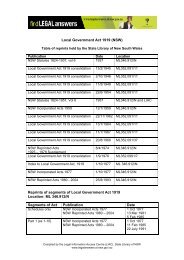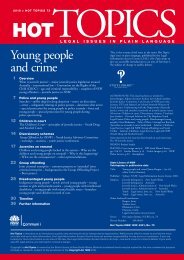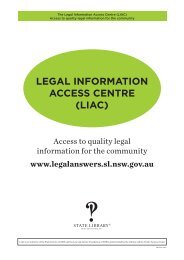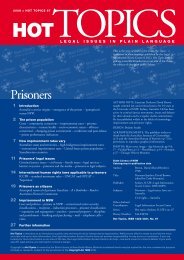Drugs and the law - Hot Topics 59 - Find Legal Answers
Drugs and the law - Hot Topics 59 - Find Legal Answers
Drugs and the law - Hot Topics 59 - Find Legal Answers
You also want an ePaper? Increase the reach of your titles
YUMPU automatically turns print PDFs into web optimized ePapers that Google loves.
in <strong>the</strong> United States by <strong>the</strong> 1938 Marijuana Tax Act(although it had already by <strong>the</strong>n been banned in 26States). Again, <strong>the</strong> Marijuana Tax Act was also strictlyspeaking a tax <strong>law</strong>, which imposed criminal penalties topunish use, possession, supply or cultivation.The United States has continued to wage a ‘War on<strong>Drugs</strong>’, both domestically <strong>and</strong> by taking a lead roleinternationally. It is <strong>the</strong> major funder <strong>and</strong> supporter of<strong>the</strong> International Narcotics Control Board, a UN bodywhich monitors compliance with international drugtreaties. There are several of <strong>the</strong>se treaties – including<strong>the</strong> 1961 Single Convention on Narcotic <strong>Drugs</strong> – whichrequire signatory states to pass <strong>law</strong>s to prohibit <strong>the</strong> use,possession, sale <strong>and</strong> production of drugs. Australiais a signatory to all <strong>the</strong> international conventions onpsychoactive drugs.Ironically, as <strong>the</strong> historian Alfred McCoy has shown,while <strong>the</strong> United States has been <strong>the</strong> most vocal promoterof international drug prohibition, actions of <strong>the</strong> UnitedStates military have given <strong>the</strong> international drug tradeits biggest boosts. First, in <strong>the</strong> Second World War,American military intelligence made arrangements withSicilian mafia figures such as Lucky Luciano to support<strong>the</strong> Allied invasion of Italy. The arrangement allowed <strong>the</strong>mafia to gain control of – <strong>and</strong> exp<strong>and</strong> – <strong>the</strong> internationalheroin trade, including into <strong>the</strong> United States. Later, inVietnam, <strong>the</strong> CIA sought alliances with <strong>the</strong> hill tribes of<strong>the</strong> Golden Triangle against <strong>the</strong> communist Viet Minh.In exchange for <strong>the</strong>ir political support, <strong>the</strong> CIA providedsubstantial transport <strong>and</strong> o<strong>the</strong>r logistical support for <strong>the</strong>hill tribes to sell opium <strong>and</strong> heroin. And United Statessoldiers in Vietnam became <strong>the</strong> major customers for <strong>the</strong>heroin, in many cases taking <strong>the</strong>ir heroin dependenceback home with <strong>the</strong>m.The Vietnam War contributed to <strong>the</strong> significant increasein drug consumption in Australia in <strong>the</strong> late 1960s,with American soldiers on ‘rest <strong>and</strong> recreation’ leave inAustralia creating a market for heroin, marijuana <strong>and</strong>o<strong>the</strong>r illicit drugs, <strong>and</strong> providing a glamorous examplefor <strong>the</strong> locals.In 1976, <strong>the</strong> Ne<strong>the</strong>rl<strong>and</strong>s adopted a policy of selectiveenforcement of its cannabis <strong>law</strong>s. The prosecutors <strong>and</strong>police are instructed to not prosecute minor offenders,<strong>and</strong> to tolerate a retail supply of cannabis through cafes.The <strong>law</strong>s prohibiting <strong>the</strong> possession <strong>and</strong> use (<strong>and</strong> supply<strong>and</strong> cultivation) of cannabis are not actually repealed,but <strong>the</strong>y are not enforced – selectively – by governmentpolicy.Several European countries have since relaxed <strong>the</strong>ir <strong>law</strong>s(or <strong>law</strong> enforcement) about possession offences, sometimesjust for cannabis. But o<strong>the</strong>r European countries continuewith a predominantly prohibitionist legal system. Swedenclaims to have achieved relatively low levels of drug usewith a firm prohibitionist approach, which includescompulsory treatment of drug users, <strong>and</strong> considerablepublic resourcing of drug rehabilitation <strong>and</strong> educationprograms, after an earlier period of liberalisation.The United Nations 2006 World Drug Report 1 indicatesthat 200 million people (5% of <strong>the</strong> world’s adultpopulation) used an illicit drug in <strong>the</strong> last twelvemonths.HarM reducTiOnHarm reduction focuses on minimising <strong>the</strong> negativeimpacts associated with drug use, individually <strong>and</strong>socially. While not advocating drug use, supporters ofharm reduction argue that we should accept that somedrug use will occur, <strong>and</strong> focus on addressing <strong>the</strong> harmscaused.This alternative approach to prohibition gained support in<strong>the</strong> 1980s, especially in Europe <strong>and</strong> Australia, <strong>and</strong> foundexpression in a number of public health programs.In response to <strong>the</strong> arrival of <strong>the</strong> HIV/AIDS p<strong>and</strong>emicin <strong>the</strong> mid 1980s, needle exchange programs wereintroduced in Australia <strong>and</strong> in several European countrieswith <strong>the</strong> aim of preventing infectious contact betweenintravenous drug users. Needle exchange remains acriminal offence in <strong>the</strong> United States.Safe injecting rooms were introduced in Europe. In 1994Switzerl<strong>and</strong> began a program of heroin prescription toheroin dependent people who had consistently failedearlier attempts at rehabilitation. The thinking is thatproviding heroin to participants gives <strong>the</strong>m a chance toachieve greater stability in <strong>the</strong>ir lives, not least because<strong>the</strong>y do not have to devote substantial time <strong>and</strong> energyto obtaining <strong>and</strong> paying for heroin. Heroin prescriptionnow operates in several European cities <strong>and</strong> Vancouver.drugs in ausTraliaThe first Australian drug <strong>law</strong> was an 1857 Act imposingan import duty on opium. In <strong>the</strong> following years,a number of o<strong>the</strong>r <strong>law</strong>s were passed imposing oftenprohibitive tariffs on opium. The primary purpose of <strong>the</strong><strong>law</strong>s was clearly to discourage <strong>the</strong> entry of Chinese peopleto Australia, ra<strong>the</strong>r than to restrict <strong>the</strong> importation ofopium itself.Australians in <strong>the</strong> nineteenth century were among <strong>the</strong>world’s biggest consumers of opiates, thanks to <strong>the</strong> verywide popularity of patent medicines, most of whichcontained a high proportion of alcohol or morphine orboth. Laudanum, a mixture of opium <strong>and</strong> alcohol, wastaken regularly by upper class matrons <strong>and</strong> administeredto children to calm <strong>the</strong>m.1. Available at www.unodc.org/unodc/en/world_drug_report.html2HOT TOPICS <strong>59</strong> > <strong>Drugs</strong> <strong>and</strong> <strong>the</strong> <strong>law</strong>
The first <strong>law</strong>s restricting opium were carefully worded toapply to opium in smokable form only – not opium as itwas taken by <strong>the</strong> European population.Cannabis plants were sent to Australia by Sir JosephBanks on <strong>the</strong> First Fleet, in <strong>the</strong> hope that <strong>the</strong> new colonymight grow enough hemp to supply <strong>the</strong> British Navywith rope. Cannabis was not consumed on a large scale(although it was readily available for sale as cigarettescalled ‘Cigares de Joy’ until <strong>the</strong> 1920s). Cannabisimportation <strong>and</strong> use was prohibited by federal legislationin 1926 (implementing <strong>the</strong> 1925 Geneva Conventionon Opium <strong>and</strong> O<strong>the</strong>r <strong>Drugs</strong>), with <strong>the</strong> States adoptingsimilar prohibition in <strong>the</strong> following years.Heroin was legally available on prescription in Australiauntil 1953. It was so widely used as a painkiller <strong>and</strong> incough mixtures that Australia was <strong>the</strong> world’s largestper capita user of heroin. The 1953 prohibition of heroinwas <strong>the</strong> result of international pressure on Australia toconform to <strong>the</strong> prohibition of heroin adopted by o<strong>the</strong>rcountries, with some opposition from <strong>the</strong> AMA.Ironically, heroin, cannabis, <strong>and</strong> o<strong>the</strong>r drugs wereprohibited in Australia well before <strong>the</strong>ir use became amajor social issue.Before <strong>the</strong> 1960s, drug use was not completely unknown,but dependent drug use was typically <strong>the</strong> result of <strong>the</strong>use of opiates after first using <strong>the</strong>m for medical reasons.There were drug dependent doctors (<strong>and</strong> <strong>the</strong>ir wives),<strong>and</strong> a small bohemian subculture that used drugs. ManyAustralian arrests for drug offences involved visiting jazzmusicians.Among <strong>the</strong> significant social changes of <strong>the</strong> 1960s was<strong>the</strong> emergence of <strong>the</strong> concept of ‘recreational’ drug use– <strong>the</strong> consumption of cannabis, heroin, LSD <strong>and</strong> o<strong>the</strong>rpsychoactive drugs for pleasure, or in pursuit of spiritualenlightenment. For <strong>the</strong> first time, drug use becamewidespread – if not quite mainstream – ra<strong>the</strong>r than anactivity pursued by a few painters or poets. The officialresponse was increased <strong>law</strong> enforcement, <strong>and</strong> legislativechange to extend <strong>the</strong> range of offences <strong>and</strong> increasedpenalties for drug offences.The ‘old’ Australian drug <strong>law</strong>s were mostly under <strong>the</strong>various state Poisons Acts, reflecting an underlyingapproach of regulation <strong>and</strong> control of medicinalsubstances, with potentially addictive drugs legallyavailable only on a doctor’s prescription. The ‘new’ drug<strong>law</strong>s introduced a distinction between use <strong>and</strong> possessionoffences, <strong>and</strong> supply offences. Penalties for possession<strong>and</strong> use increased, but very substantial penalties wereintroduced for drug supply, <strong>and</strong> especially supply of largequantities (‘drug trafficking’). By 1970, all <strong>the</strong> states hadenacted <strong>law</strong>s that made drug supply a separate offence todrug use or possession offences.In 1985, <strong>the</strong> federal <strong>and</strong> state governments adopted aNational Drug Strategy which included a pragmaticmixture of prohibition <strong>and</strong> a stated objective of harmreduction. Harm reduction has been an official partof Australian drugs policy ever since, although mostresources by far are devoted to policing <strong>and</strong> border patrolattempts at interdiction (‘supply reduction’). Fewerresources are made available for health treatment <strong>and</strong>drug rehabilitation programs, or for preventative publichealth programs such as needle exchange.The needle exchange program has been successful.Australia maintains an extremely low rate of HIVinfection among injecting drug users, compared toinfection rates of 60% or more among injecting drugusers in some US cities, where needle exchange remainsillegal. The success of <strong>the</strong> needle exchange programsencouraged governments to at least consider adoptingo<strong>the</strong>r harm minimisation initiatives.image u navailableJason South, The Age (Melbourne).history of drug <strong>law</strong>s 3
The merits of a trial of a heroin prescription program,based on <strong>the</strong> Swiss model, were debated in <strong>the</strong> 1990s.The ACT government took steps to begin a trialprogram, but <strong>the</strong> Federal Government refused to allow<strong>the</strong> importation of heroin. Unable to source legitimate<strong>and</strong> controlled quality heroin, <strong>the</strong> ACT governmentab<strong>and</strong>oned <strong>the</strong> proposed trial.Australia has been tentative about allowing legal injectingrooms, with NSW <strong>the</strong> only state to permit an injectingroom, <strong>and</strong> <strong>the</strong>n only one, on a trial basis.In all states, <strong>the</strong> impact of prohibitionist <strong>law</strong>s on drugusers is somewhat modified by a number of diversionprograms, diverting some eligible users from <strong>the</strong> criminaljustice system to cautions or treatment.THe drug pOlicy debaTePublic debate over drug policy <strong>and</strong> calls for ‘drug <strong>law</strong>reform’ began in <strong>the</strong> late 1960s <strong>and</strong> has continued since.The opposition to prohibition was at first largely anargument on libertarian grounds: that people shouldhave <strong>the</strong> right to consume drugs if <strong>the</strong>y hurt nobodydoing so, positing drug offences as victimless crimes.Those arguments are still made.However, most arguments for reform today come from<strong>the</strong> harm reduction perspective. It is suggested that <strong>the</strong>legal prohibition of drugs creates crime, <strong>and</strong> makesdrug-taking more physically dangerous. Prohibitionalso requires significant public expenditure withoutpreventing significant levels of problematic drug use in<strong>the</strong> community.The primary argument against relaxation of <strong>the</strong> criminal<strong>law</strong> treatment of drugs is that it would cause drug use toincrease, <strong>and</strong> consequently lead to an increase in drugdependence. The social cost of drug use would likely riseif drugs became more freely available <strong>and</strong> more freelyconsumed. Although prohibition cannot completelyprevent drug use, <strong>the</strong> risk of being caught by <strong>the</strong> policehas a directly discouraging effect on drug users <strong>and</strong>would-be drug users. Prohibition forces drug priceshigher, indirectly discouraging drug use.It is also argued that having <strong>law</strong>s which make drug use(<strong>and</strong> supply) illegal has a symbolic effect, ‘sending amessage’ that drug use is socially undesirable.image u navailableAn ‘ice pipe’ used for smoking crystal methamphetamine. Taken 30 July 2003.Shannon Morris, The Age (Melbourne).4HOT TOPICS <strong>59</strong> > <strong>Drugs</strong> <strong>and</strong> <strong>the</strong> <strong>law</strong>
The counter argument is that making some drugs illegal<strong>and</strong> yet allowing demonstrably harmful drugs liketobacco <strong>and</strong> alcohol to be freely available to adults ishypocritical <strong>and</strong> undermines respect for <strong>the</strong> <strong>law</strong> <strong>and</strong> o<strong>the</strong>rsocial institutions. Forcing up <strong>the</strong> price of drugs doesnot prevent people using drugs, but it might encouragepeople to commit property crimes, or to engage in drugsupply offences, to obtain <strong>the</strong> necessary funds.The enforcement of <strong>law</strong>s criminalising drug use cancontribute to risk taking behaviours – for example,injecting drugs alone, or consuming party drugs all atonce to avoid sniffer dog detection.There is a good deal of evidence to suggest that <strong>the</strong>re is alink between illicit drug use <strong>and</strong> property crime, but <strong>the</strong>evidence is less strong in proving that drug use actuallycauses property crime. It may be that people who commitproperty crime are more likely to be drug users, so thatdrug use is not a cause. But it is clear that at least somedrug-dependent people commit very large numbers ofproperty crimes.Similarly, <strong>the</strong>re is a good deal of evidence to suggesta connection between cannabis use by teenagers <strong>and</strong>psychosis, but <strong>the</strong> evidence is less strong that cannabisactually causes psychosis. Most studies cannot rule outo<strong>the</strong>r drug use (especially amphetamines) as a potentialcause of mental health problems, <strong>and</strong> it may be thatpeople with mental health problems are more likelythan o<strong>the</strong>rs to use cannabis (so that <strong>the</strong> cannabis useis a feature, but not a cause). It is interesting that <strong>the</strong>national prevalence of psychosis in young people has notincreased over <strong>the</strong> last twenty years, despite significantincrease in cannabis use by young people.The drugs policy debate is one in which most argumentscan be supported by evidence from a study somewhereor an experience in one country or ano<strong>the</strong>r. It can beargued that prohibition causes drug crime <strong>and</strong> preventsdrug crime; that it discourages drug use or that itencourages harmful drug use; it complements efforts atdrug rehabilitation or it draws valuable resources awayfrom treatment programs.The debate about <strong>the</strong> relative merits of <strong>the</strong>se broadpolicy positions is not likely to end soon. However, it islikely that we will continue to see a variety of new <strong>law</strong>s<strong>and</strong> measures introduced – at times prohibitionist <strong>and</strong>at times harm reductionist – in an ongoing attempt toaddress <strong>the</strong> social consequences of drug use.discriMinaTiOn againsTdrug usersThe social stigma attached to illicit drug use meansthat people who are identified as drug users canexperience discriminatory treatment such as denial ofservices or accommodation.is drug addiction a disability?Under both NSW <strong>and</strong> federal anti-discrimination<strong>law</strong>s, it is un<strong>law</strong>ful to discriminate against a person on<strong>the</strong> grounds of disability. Over a number of years, ithad been frequently suggested that drug dependencewas a form of disability, <strong>and</strong> <strong>the</strong>refore covered by <strong>the</strong>discrimination <strong>law</strong>s, but <strong>the</strong>re was no case deciding<strong>the</strong> point.Drug addiction <strong>and</strong> federal <strong>law</strong>In Marsden v HREOC <strong>and</strong> Coffs Harbour RSL [2000]FCA 1619, a man was refused alcohol service at a club,<strong>and</strong> later expelled from club membership, because hewas on a methadone program. He made a complaintof disability discrimination to <strong>the</strong> Human Rights <strong>and</strong>Equal Opportunity Commission (HREOC). Thecommission conducted an inquiry <strong>and</strong> concluded<strong>the</strong>re had been no disability discrimination. Marsdenappealed to <strong>the</strong> Federal Court, which decided thatdrug addiction could be classed as a disability for<strong>the</strong> purposes of <strong>the</strong> relevant federal legislation (<strong>the</strong>Disability Discrimination Act 1992).amendments to nsW <strong>law</strong>In response to <strong>the</strong> Marsden decision, <strong>the</strong> NSW Government amended <strong>the</strong> NSW <strong>law</strong> (<strong>the</strong> Anti-Discrimination Act 1977) to legally allow discrimination against a person on <strong>the</strong> grounds of addiction to a prohibited drug – but only in employment. Discrimination remains un<strong>law</strong>ful in o<strong>the</strong>r fields, including:> providing goods <strong>and</strong> services> education> accommodation.The NSW Act does not allow discrimination: > against users of methadone or buprenorphine> on <strong>the</strong> grounds of being hepatitis C or HIV positive, or having any o<strong>the</strong>r medical condition.So, if a person is refused a job because <strong>the</strong>y areon a methadone or buprenorphine program or areseropositive, <strong>the</strong>y could make a claim for disabilitydiscrimination under <strong>the</strong> NSW Act.history of drug <strong>law</strong>s 5
Drug <strong>law</strong>s inNSW WHaT are illegal drugs?In NSW, it is an offence to possess, use, produce orsupply a drug which has been declared prohibited. Mostdrug charges in NSW are laid under <strong>the</strong> Drug Misuse <strong>and</strong>Trafficking Act 1985. The Commonwealth Customs Act1901 covers offences involving importing <strong>and</strong> exportingdrugs.THe drug Misuse <strong>and</strong> TraffickingacT 1985The NSW Drug Misuse <strong>and</strong> Trafficking Act 1985classifies a wide range of drugs as ‘prohibited drugs’ (<strong>and</strong>‘prohibited plants’ in <strong>the</strong> case of cannabis, opium <strong>and</strong>coca). The Act creates offences for:> use of prohibited drugs> possession of prohibited drugs> supply <strong>and</strong> trafficking of prohibited drugs (with <strong>the</strong>seriousness of <strong>the</strong> offence depending on <strong>the</strong> quantitiesinvolved)> cultivation <strong>and</strong> possession of prohibited plants> manufacture of prohibited drugs> aiding <strong>and</strong> abetting <strong>and</strong> taking part in offencesinvolving prohibited drugs or plants> possession of drug-use implements.Specific offences are covered in more detail from pp 816.The drugs covered by <strong>the</strong> Act are listed in a schedule.They include <strong>the</strong> common street drugs – cannabis(marijuana), heroin, ecstasy, amphetamines, LSD,cocaine, methadone – <strong>and</strong> many o<strong>the</strong>rs.THe cusTOMs acTThe Customs Act 1901 is a federal <strong>law</strong> that aims, amongo<strong>the</strong>r things, to prevent <strong>the</strong> import <strong>and</strong> export ofprohibited drugs. The range of drugs (listed in a scheduleto <strong>the</strong> Act) is similar to that in <strong>the</strong> Drug Misuse <strong>and</strong>Trafficking Act.Customs Act offences include dealing with importeddrugs after <strong>the</strong>y have been brought into <strong>the</strong> country.cOnfiscaTing prOceeds Of criMeThere is both NSW <strong>and</strong> federal legislation that canbe used to seize assets obtained through serious drugoffences, <strong>and</strong> o<strong>the</strong>r offences. Some of <strong>the</strong>se <strong>law</strong>s applyonly after a person is convicted of an offence. Some applywithout a conviction, or even without a criminal chargebeing laid.These confiscation <strong>law</strong>s do not apply to minor drugoffences, such as use <strong>and</strong> possession, or small-scaledealing.The Acts that come into operation after conviction are:> <strong>the</strong> Confiscation of Proceeds of Crime Act 1989 (NSW)> <strong>the</strong> Proceeds of Crime Act 1987 (Cth).The Acts that apply regardless of criminal conviction are: > <strong>the</strong> Criminal Assets Recovery Act 1990 (NSW)> <strong>the</strong> Customs Act 1901 (Cth), sections 229A <strong>and</strong> 243B. how cases proceedCases run under <strong>the</strong>se <strong>law</strong>s are civil, not criminalactions. This means that a person does not get a criminalrecord if <strong>the</strong> court orders forfeiture of <strong>the</strong>ir property,or <strong>the</strong> payment of a monetary penalty. It also meansthat <strong>the</strong> court must only be satisfied on <strong>the</strong> balance ofprobabilities (not beyond reasonable doubt) that <strong>the</strong>property in question is tainted. NSW cases are conductedin <strong>the</strong> Supreme Court, with proceedings brought by <strong>the</strong>NSW Drug Crime Commission. Federal cases are run in<strong>the</strong> Federal Court.inTernaTiOnal TreaTies <strong>and</strong>cOnvenTiOnsAustralia is a signatory to a number of internationaltreaties <strong>and</strong> conventions about drugs <strong>and</strong> drug policy.These treaties are all prohibitionist in <strong>the</strong>ir basic intent.Countries that sign <strong>the</strong>se treaties must agree to pass <strong>law</strong>sagainst using <strong>and</strong> trading of recreational drugs.International treaties <strong>and</strong> conventions are not <strong>law</strong> inAustralia. The only <strong>law</strong> in NSW is legislation passedby state or federal parliament <strong>and</strong> precedent decisions6HOT TOPICS <strong>59</strong> > <strong>Drugs</strong> <strong>and</strong> <strong>the</strong> <strong>law</strong>
made by <strong>the</strong> courts. The legal status of <strong>the</strong> treaties isto guide <strong>the</strong> federal government. In some cases, treatiesgive <strong>the</strong> federal government constitutional power topass <strong>law</strong>s it might not o<strong>the</strong>rwise have had. New SouthWales <strong>and</strong> o<strong>the</strong>r Australian states are not signatoriesto international treaties so <strong>the</strong>y are not strictly legallybound by <strong>the</strong>ir terms, although <strong>the</strong>re is a tradition thatstates <strong>and</strong> provinces should act consistently with treatiesentered by <strong>the</strong>ir national governments.The main international treaties about drugs that Australiahas signed are:> <strong>the</strong> Single Convention on Narcotic <strong>Drugs</strong> 1961> <strong>the</strong> Convention on Psychotropic Substances 1971> <strong>the</strong> United Nations Convention Against Illicit Trafficin Narcotic <strong>Drugs</strong> <strong>and</strong> Psychotropic Substances 1988These treaties require <strong>the</strong> nations that sign <strong>the</strong>m to pass<strong>law</strong>s imposing criminal penalties on drug use, possession<strong>and</strong> supply. However, <strong>the</strong> treaties also allow for flexibility.For example, <strong>the</strong>y allow signatory countries to permit <strong>the</strong>use of prohibited drugs for medical purposes.Importantly, <strong>the</strong> treaties also provide an option to divertdrug offenders to rehabilitation <strong>and</strong> treatment programs,instead of imposing criminal punishments.finding acTs <strong>and</strong> casesnsW legislationwww.legislation.nsw.gov.auSelect <strong>the</strong> Browse A-Z in force option to find NSW Acts <strong>and</strong>regulations.commonwealth legislationwww.austlii.edu.auFor current legislation click on Commonwealth on <strong>the</strong> lefth<strong>and</strong> side of <strong>the</strong> home page <strong>and</strong> <strong>the</strong>n choose CommonwealthConsolidated Acts to find Acts, or CommonwealthConsolidated Regulations to find Regulations.international conventionsGo to http://www.austlii.edu.au/au/o<strong>the</strong>r/dfat/ to search <strong>the</strong>Australian Treaties Library for treaties to which Australia isa party.cases from courts <strong>and</strong> tribunalswww.austlii.edu.auEi<strong>the</strong>r type <strong>the</strong> case name into <strong>the</strong> search box, or select<strong>the</strong> jurisdiction from <strong>the</strong> left h<strong>and</strong> side of <strong>the</strong> home page,eg Commonwealth or NSW, <strong>and</strong> <strong>the</strong>n select <strong>the</strong> court ortribunal where <strong>the</strong> case was heard. Links to legislationfrom o<strong>the</strong>r Australian jurisdictions can be found atwww.liac.sl.nsw.gov.au/legislation/index.cfmNot all cases are available on AustLII – if you needhelp locating any of <strong>the</strong> cases mentioned in <strong>Hot</strong> <strong>Topics</strong>,legislation or fur<strong>the</strong>r legal information contact LIAC(02) 9273 1558 or liac@sl.nsw.gov.auimage u navailableA joint federal, NSW police <strong>and</strong> Customs investigation spanning Australia, <strong>the</strong> US <strong>and</strong> Europe, intercepted 340kg of <strong>the</strong>key ecstasy component MDMA, concealed in packets of frozen Chinese wontons aboard a container ship. The drugs –-enough to make 1.36 million tablets of ecstasy <strong>and</strong> worth $68 million on <strong>the</strong> streets – had come from The Ne<strong>the</strong>rl<strong>and</strong>svia <strong>the</strong> US before l<strong>and</strong>ing at Sydney's Port Botany. 21 June 2004.Steven Siewert, Sydney Morning Herald.Drug <strong>law</strong>s in nsW 7
<strong>the</strong> case of <strong>the</strong> household drugsA man lived with his girlfriend, his mo<strong>the</strong>r, hisbro<strong>the</strong>r <strong>and</strong> ano<strong>the</strong>r couple in a three bedroom house.The police found marijuana inside <strong>the</strong> lounge in <strong>the</strong>living area, a room to which all <strong>the</strong> occupants hadregular access. The man’s conviction was overturnedon appeal. The Court of Criminal Appeal said thatit was necessary to prove that he had <strong>the</strong> drugs in hisexclusive physical control, <strong>and</strong> that this was difficultbecause of <strong>the</strong> large number of people having equallyfree access to <strong>the</strong> room in which <strong>the</strong>y were found(Filippetti v R (1984) 13 A Crim R 335).The prosecution must rule out all o<strong>the</strong>r reasonableexplanations. If <strong>the</strong>re is <strong>the</strong> possibility of several peoplehaving access to <strong>the</strong> drugs, <strong>the</strong>re is room for reasonabledoubt about whe<strong>the</strong>r <strong>the</strong> drugs are possessed by <strong>the</strong>accused. They could be possessed by someone else.charges against several personsIf a number of people are charged with possession in thissituation, <strong>the</strong> prosecution must prove in each case that<strong>the</strong> person charged had possession of <strong>the</strong> drugs.This can be difficult. Courts are not allowed to presumethat all <strong>the</strong> people must have shared possession – eachindividual accused is presumed innocent. Withoutadmissions (‘Yeah, I knew <strong>the</strong> dope was in <strong>the</strong>cupboard…’), it may be difficult to prove that any one of<strong>the</strong> accused is guilty of possession.So for most convictions <strong>the</strong>y must rely on admissionsmade by <strong>the</strong> accused.intoxication as a defence to criminal chargesSelf-induced intoxication with illegal drugs does notprovide defence to criminal charges.Drink spikingThe offence of administering a prohibited drug includesdrink spiking, where a prohibited drug is added tosomeone’s alcoholic drink, <strong>and</strong> <strong>the</strong> person is not aware<strong>and</strong> does not consent to <strong>the</strong> administration of <strong>the</strong> drug.MethadoneIt is an offence to inject methadone. Methadone is legallyprescribed subject to conditions on quantity <strong>and</strong> <strong>the</strong>‘purpose’ of <strong>the</strong> prescription, which must be accordingto ‘recognised <strong>the</strong>rapeutic st<strong>and</strong>ards’ (NSW Poisons <strong>and</strong>Therapeutic Goods Regulation 2002, reg 79).Medicinal cannabisIt is not a defence to a charge of possession of cannabis(or self-administration or cultivation of cannabis) that<strong>the</strong> person used <strong>the</strong> cannabis for a legitimate medicalreason. However, such motivation can be a relevant issueto be taken into account in sentencing.The NSW government has announced that it willintroduce legislation to allow <strong>the</strong> use of medicinalcannabis in at least some circumstances. This follows areport from an expert working party (in August 2000) 2which recommended that possession <strong>and</strong> use of smallquantities of cannabis, <strong>and</strong> <strong>the</strong> cultivation of a smallnumber of cannabis plants, should be made <strong>law</strong>ful tosufferers of certain conditions <strong>and</strong> illnesses, <strong>and</strong> forcarers of people with those conditions or illnesses.image u navailableuseUsing an illegal drug (also known as ‘self-administration’)is an offence under section 12 of <strong>the</strong> Drug Misuse <strong>and</strong>Trafficking Act. The police must prove that <strong>the</strong> substanceconsumed was a prohibited drug. Obviously <strong>the</strong>y cannotanalyse <strong>the</strong> substance if it has been completely consumed,<strong>and</strong> blood tests can only be taken by a doctor after arrest.Cannabis (Cannabis sativa), young leaves.2. Report available at www.druginfo.nsw.gov.au/medicinal_use_of_cannabis/medicinal_cannabis_nswpossession, use <strong>and</strong> supply 9
The ‘purpose’ specified in methadone prescriptions isoral dose. Administration by any o<strong>the</strong>r method means<strong>the</strong> methadone is not <strong>law</strong>fully prescribed under section12(2) of <strong>the</strong> DMTA <strong>and</strong> is illegal.prescription drugsIt is legal to possess <strong>and</strong> use some drugs, like methadone<strong>and</strong> <strong>the</strong> benzodiazepines (such as Serapax <strong>and</strong> Valium), if<strong>the</strong>y have been prescribed by a doctor. It is only an offenceto possess or use <strong>the</strong>se drugs without a prescription.administering drugs to o<strong>the</strong>rsIt is also an offence to administer a drug to someoneelse, for example by injecting <strong>the</strong>m (section 13), or toallow someone to administer drugs (section 14). It is anoffence even if <strong>the</strong> person consents to <strong>the</strong> drug beingadministered to <strong>the</strong>m.if someone diesA person who injects someone else with a drug thatcauses <strong>the</strong>ir death may be charged with manslaughter.Manslaughter means causing an un<strong>law</strong>ful death where<strong>the</strong> intention was not to kill or inflict a serious injury, butto inflict a minor injury or commit some o<strong>the</strong>r criminaloffence.getting medical helpIf an overdose or o<strong>the</strong>r emergency situation involvingdrug use occurs, you should call an ambulance or seeko<strong>the</strong>r suitable medical help. It is obviously <strong>the</strong> bestmedical option for <strong>the</strong> person who has overdosed.The ambulance service does not notify <strong>the</strong> police whenit attends a drug overdose. Hospitals <strong>and</strong> doctors alsodo not notify <strong>the</strong> police if you go to <strong>the</strong>m requestingmedical attention.Police sometimes do attend overdose scenes. But policeguidelines are designed to encourage people to seekmedical help when necessary. So police are directed notmake arrests of an overdose victim or <strong>the</strong>ir friends, orany o<strong>the</strong>r people who are present at an overdose <strong>and</strong> mayhave also consumed drugs or be in possession of drugs.injecting roomsThe NSW government has permitted <strong>the</strong> establishmentof one licensed medically supervised injecting centre(in Kings Cross) on a trial basis. The centre’s licence isissued under section 36E of <strong>the</strong> DMTA.It is <strong>law</strong>ful for a person to use or possess a small quantityof a prohibited drug while in <strong>the</strong> injecting centre (section36N). Police guidelines also encourage <strong>the</strong> exercise ofdiscretion to not arrest or charge a person who is on <strong>the</strong>irway to or from, or in <strong>the</strong> vicinity of, <strong>the</strong> injecting centrewith possession offences. Supply offences in or near <strong>the</strong>injecting centre are policed.It is an offence for anyone except <strong>the</strong> operators of<strong>the</strong> licensed injecting centre to ‘advertise or hold outin any way’ that <strong>the</strong>ir premises are available for <strong>the</strong>administration of a prohibited drug (section 18A).supplySupply is very broadly defined (section 3) to includenot only selling or giving away drugs but also simplyagreeing to supply <strong>the</strong>m.Supply also includes ‘deemed supply’ – possessingcertain quantities of drugs which are deemed to be for<strong>the</strong> purpose of supply.A person can be charged with supply if <strong>the</strong>y tell police<strong>the</strong>y intended to sell even a small quantity of drugs foundin <strong>the</strong>ir possession, or if <strong>the</strong>y deliver drugs to a friend.They are also guilty of supply if <strong>the</strong>y simply offer tosupply a drug, even if <strong>the</strong>y have no hope, or no intention,of fulfilling <strong>the</strong> offer.What if it isn’t really a drug?If a person offers a substance to someone <strong>and</strong> says that itis a drug to persuade that person to buy or take it, <strong>the</strong>yare guilty of supplying <strong>the</strong> drug whe<strong>the</strong>r <strong>the</strong> substanceis actually <strong>the</strong> drug or not (section 40). For example,a person who offers to supply someone with heroinwhen all <strong>the</strong>y have is icing sugar is considered guilty ofsupplying heroin.This is <strong>the</strong> case whe<strong>the</strong>r <strong>the</strong>y have made a genuinemistake or are deliberately attempting to cheat <strong>the</strong>buyer.(For possession <strong>and</strong> use offences <strong>the</strong> court must besatisfied that <strong>the</strong> substance is in fact a prohibited drug.)Deemed supplyA person will be presumed to be supplying a drug if <strong>the</strong>yare simply in possession of a particular quantity of <strong>the</strong>drug, known as <strong>the</strong> traffickable quantity. This amountvaries from one drug to ano<strong>the</strong>r, <strong>and</strong> in many cases is notespecially large.<strong>the</strong> case of <strong>the</strong> split stashA man was charged with possession of cannabis intwo separate premises. The combined weight exceeded<strong>the</strong> traffickable amount. He was convicted of deemedsupply. His appeal was unsuccessful: <strong>the</strong> court saidthat because he had bought all <strong>the</strong> drugs at <strong>the</strong> sametime, <strong>and</strong> <strong>the</strong>y were <strong>the</strong> same texture <strong>and</strong> colour,<strong>the</strong>re had been no miscarriage of justice (R v Wright,unreported CCA (NSW), 18 July 1986).10HOT TOPICS <strong>59</strong> > <strong>Drugs</strong> <strong>and</strong> <strong>the</strong> <strong>law</strong>
traffickable quantitiesA traffickable quantity of a drug is an amount deemedin <strong>law</strong> to be in a person’s possession for <strong>the</strong> purpose ofsupply. Some traffickable quantities are:> cannabis (leaf or heads) – 300 gm> heroin – 3 gm> amphetamines – 3 gm> ecstasy – 3 gm or 15 tabs> LSD – 0.003 gm or 15 tabs.Purity does not matter – only weight. Under <strong>the</strong> Act, onegram of a powder that is 10% heroin <strong>and</strong> 90% glucose istreated as one gram of pure heroin (section 4).Anybody found in possession of a traffickable quantityis presumed to be a supplier unless <strong>the</strong>y can proveo<strong>the</strong>rwise – for example, that <strong>the</strong> drug was intended forpersonal use, or disposal (section 29).<strong>the</strong> case of <strong>the</strong> sister’s stashA woman was found with ‘deemed supply’ quantitiesof cannabis <strong>and</strong> cocaine in her bedroom. She toldpolice that her sister had given <strong>the</strong>m to her to lookafter, <strong>and</strong> that if <strong>the</strong> sister had not picked <strong>the</strong>m up<strong>the</strong> next day she would dispose of <strong>the</strong>m. She wasfound guilty of possession, but not supply – becauseshe could prove that she was not in possession of <strong>the</strong>drugs for <strong>the</strong> purposes of supply (R v Carey (1990) 20NSWLR 292).police directions in public placesPolice can legally give a ‘reasonable direction’ to a personin a public place who <strong>the</strong>y believe on reasonable groundsis supplying, or soliciting supply of, or purchasingprohibited drugs. The direction must be ‘reasonable in<strong>the</strong> circumstances for <strong>the</strong> purpose of stopping’ <strong>the</strong> supplyor purchase. It is an offence to fail to comply with <strong>the</strong>direction without reasonable excuse (Law Enforcement(Powers <strong>and</strong> Responsibilities) Act 2002, section 197).ongoing dealingSection 25A of <strong>the</strong> Act creates a special offence ofsupplying drugs on an ongoing basis. The offenceinvolves <strong>the</strong> supply of a prohibited drug (exceptcannabis) on three separate occasions within a 30 dayperiod. The acts of supply must be for some financial oro<strong>the</strong>r material reward. They do not all have to involve<strong>the</strong> same drug.A charge of ongoing dealing could be laid where anundercover police officer buys drugs from <strong>the</strong> same streetdealer on three different days. The police are not obligedto arrest <strong>the</strong> dealer immediately after <strong>the</strong> first sale.The maximum penalty for ongoing dealing is a $385,000fine <strong>and</strong> 20 years jail, regardless of <strong>the</strong> weight of <strong>the</strong>drug supplied or <strong>the</strong> value of <strong>the</strong> transactions. This isequivalent to <strong>the</strong> maximum penalty for <strong>the</strong> supply of acommercial quantity of drugs (250 grams of heroin oramphetamine, or 500 grams of ecstasy).The NSW Court of Criminal Appeal has ruled that asentence for this offence of four <strong>and</strong> half years (with aminimum term of two <strong>and</strong> half years) is not excessive,even if <strong>the</strong> amount of drug supplied was only small <strong>and</strong><strong>the</strong> supplier was motivated by <strong>the</strong>ir own addiction ra<strong>the</strong>rthan greed 3 .This offence is classed as wholly indictable, which meansit must be finalised in <strong>the</strong> District Court ra<strong>the</strong>r than <strong>the</strong>Local Court. A person convicted of an offence under thissection (<strong>and</strong> o<strong>the</strong>r indictable offences) is not eligible tobe dealt with by <strong>the</strong> Drug Court.Large scale supplyHigher penalties apply for charges involving <strong>the</strong> supply of larger amounts of drugs. The Act divides trafficking offences into:> indictable quantities > commercial quantities > large commercial quantities. As with deemed supply, proof of possession of <strong>the</strong> relevant quantity is sufficient to establish that a person is guilty of that particular trafficking offence. The table shows <strong>the</strong> scheduled quantities.DRUG inDictable commeRciallaRGecommeRcialCannabis 1 kg 25 kg 100 kgleaf/headsHeroin 5 gm 250 gm 1 kgAmphetamine 5 gm 250 gm 1 kgEcstasy 5 gm/ 0.5 kg 2 kg25 tabsLSD0.005 gm/ 0.5 gm 2 gm25 tabspenaltiesThe maximum penalty for dealing with an indictablequantity of a drug is a $220,000 fine <strong>and</strong> 15 yearsimprisonment (10 years for cannabis).For a quantity of drugs in <strong>the</strong> commercial range, <strong>the</strong>maximum penalty is a $385,000 fine <strong>and</strong> 20 years jail(15 years for cannabis).For a large commercial quantity, fines of $550,000<strong>and</strong> life imprisonment (20 years for cannabis) can beimposed.[Note: penalties accurate as at 1 February 2007.]3. R v Smiroldo [2000] NSWCCA 120; available at http://www.austlii.edu.au/au/cases/nsw/NSWCCA/2000/120.htmlpossession, use <strong>and</strong> supply 11
O<strong>the</strong>r offencesdrug use equipMenTIt is an offence under <strong>the</strong> Drug Misuse <strong>and</strong> Trafficking Act1985 (NSW) (<strong>the</strong> ‘DMTA’) to possess equipment with<strong>the</strong> intention of using it to consume drugs (section 11).The use must be future use. Evidence that <strong>the</strong> equipmenthas been used in <strong>the</strong> past is not relevant or sufficient toprove <strong>the</strong> charge 4 . The prosecution must show that <strong>the</strong>equipment was illegally possessed. The <strong>law</strong> is <strong>the</strong> sameas for possession – <strong>the</strong>re must be knowledge <strong>and</strong> custodyor control.injecting equipmentIt is not an offence to possess a needle or syringe, whe<strong>the</strong>rit has been used or not (section 11(1A)).It is (technically) an offence to possess o<strong>the</strong>r injectingequipment, such as tourniquets, spoons, <strong>and</strong> swabs. Inpractice, possession of this equipment is not prosecuted.sale of bongs <strong>and</strong> pipesIt is an offence to sell, supply or display for sale a bongor ice pipe, or <strong>the</strong> component parts of a bong or pipe,whe<strong>the</strong>r or not <strong>the</strong> bong or pipe was intended to be usedto administer a prohibited drug (section 11A).Offences invOlving prOHibiTedplanTsThe cultivation or possession of prohibited plants, suchas cannabis, is an offence under section 23.It is an offence under s 23(1) to:> cultivate> knowingly take part in <strong>the</strong> cultivation of> possess> supplya prohibited plant.What is included?Cultivation is defined to include sowing seed, planting,tending, nurturing or harvesting (section 3).Watering a plant, shading it from <strong>the</strong> sun, picking <strong>the</strong>heads off a friend’s plant, even watering ungerminatedseeds, all come within <strong>the</strong> definition of cultivation.And possession of plants is also an offence under <strong>the</strong>same section <strong>and</strong> with <strong>the</strong> same maximum penalty asfor cultivation. There may be no evidence of cultivation,but evidence of possession (again, requiring proof ofknowledge <strong>and</strong> custody or control) of <strong>the</strong> plants, inwhich case that should be <strong>the</strong> charge laid.QuantitiesThe penalty categories for cultivating cannabis dependon <strong>the</strong> number of plants, not <strong>the</strong>ir gender or size.Cultivating a hundred seedlings that can fit into abaking tray is treated <strong>the</strong> same as cultivating a hundredmature female plants. Having 250 seedlings is regardedas more serious than having five big plants, even though<strong>the</strong> weight of <strong>the</strong> five big plants may be many timesgreater.Higher penalties apply to offences involving <strong>the</strong>cultivation, supply <strong>and</strong> possession of a ‘commercialquantity’ of prohibited plants.Defences to cultivationIt is a defence to a charge of cultivation of a prohibitedplant if <strong>the</strong> accused can establish that <strong>the</strong>y did not know<strong>the</strong> plant was a prohibited plant. The accused mustinform <strong>the</strong> court if <strong>the</strong>y propose to give such evidence(s 23(4)(a)(i)). The onus of proof in this situation is on<strong>the</strong> accused (s 40A(2)).The prosecution may rebut <strong>the</strong> accused’s evidenceby bringing, with leave of <strong>the</strong> court, evidence of anyprevious convictions (s 23(5)).hydroponic cultivationSection 3 defines ‘cultivation by enhanced indoor means’ to be cultivation that occurs:> ‘inside a building or structure’ <strong>and</strong>> involves <strong>the</strong> nurture of <strong>the</strong> plant in nutrient enrichedwater or application of artificial light or heat orsuspending <strong>the</strong> roots <strong>and</strong> spraying <strong>the</strong>m with nutrientsolution.4. Erickson v Pittard [1976] 2 NSWLR 52812HOT TOPICS <strong>59</strong> > <strong>Drugs</strong> <strong>and</strong> <strong>the</strong> <strong>law</strong>
Section 23(1A) prohibits <strong>the</strong> ‘cultivation by enhancedindoor means’ of five or more plants for a commercialpurpose. ‘Commercial purpose’ means intending to sellor believing that ano<strong>the</strong>r person intended to sell – section23(6). [Note that <strong>the</strong> offence of (outdoor) cultivation ofcannabis in s 23(1) does not involve any requirement toprove a commercial purpose.]So <strong>the</strong> offence requires <strong>the</strong> cultivation to be:> inside a building or structure <strong>and</strong>> involve growing <strong>the</strong> plant in nutrient enriched water orapplying artificial light or heat or suspending <strong>the</strong> roots<strong>and</strong> spraying <strong>the</strong>m with nutrient solution <strong>and</strong>> involve five or more plants <strong>and</strong>> be done with <strong>the</strong> intention to sell (or <strong>the</strong> beliefthat ano<strong>the</strong>r person intends to sell) <strong>the</strong> cannabisproduced.Offences under section 23(1A) are wholly indictable.They must be dealt with in <strong>the</strong> District Court.offence categoriesThere are now two entries for cannabis as ‘prohibitedplants’ in <strong>the</strong> Schedule (‘cannabis cultivated by enhancedindoor means’ <strong>and</strong> ‘cannabis cultivated by any o<strong>the</strong>rmeans’). The relevant offence categories in <strong>the</strong> Scheduleare as follows:tRaffickableqUantitysmallqUantityinDictableqUantitycommeRcialqUantitylaRGecommeRcialqUantityhydro – 5 50 50 200outdoor – 5 50 250 1000penaltiesCultivation of less than <strong>the</strong> ‘small quantity’ of hydroponicplants (that is, less than 5 plants) is treated <strong>the</strong> same asfor outdoor cannabis plants. If dealt with summarily, <strong>the</strong>maximum penalty is $5500 <strong>and</strong> two years imprisonment(s 30(3)) or $220 000 or ten years if dealt with onindictment (s 32(1)(h)).The maximum penalty for cultivation of 5 to 49hydroponic plants is $385 000 <strong>and</strong> 15 years imprisonment(s 33(2)(b)). For cultivation of 50 or more hydroponicplants, <strong>the</strong> maximum penalty is also $385 000 <strong>and</strong> 15years imprisonment (s 33(2)(b)).For 200 or more hydroponic plants, a ‘large commercialquantity’, <strong>the</strong> maximum penalty is $550 000 <strong>and</strong> 20years imprisonment (s 33(3)(b)).exposing a child to indoor cultivationSection 23A(1) makes it an offence to cultivate ‘a plant’(note <strong>the</strong> singular) by enhanced indoor means <strong>and</strong>‘expose a child’ to <strong>the</strong> cultivation process or to substancesstored for use in cultivation.The maximum penalty for an exposing a child offenceinvolving one to four plants is a fine of $11 000 <strong>and</strong>two years imprisonment if dealt with summarily, or a$264 000 fine <strong>and</strong> 12 years imprisonment if heard onindictment.The maximum penalty for an exposing a child offencethat involves five to 199 plants is a $462 000 fine <strong>and</strong>18 years imprisonment. The maximum penalty for anexposing a child offence that involves 200 or more plantsis a $660 000 fine <strong>and</strong> 24 years imprisonment. Theseoffences are wholly indictable.It is a defence if <strong>the</strong> defendant can prove that <strong>the</strong>exposure did not endanger <strong>the</strong> health <strong>and</strong> safety of <strong>the</strong>child. A child is a person under 16 for <strong>the</strong> purposes of<strong>the</strong>se provisions.ManufacTuring drugsIt is an offence to manufacture, or to take part in <strong>the</strong>manufacture of, a prohibited drug, under section 24.The maximum penalty for manufacture of a prohibiteddrug depends on <strong>the</strong> quantity involved, with <strong>the</strong> samepenalties applying as for supply offences involvingcomparable amounts.The maximum penalty for manufacturing an indictablequantity of a drug is a $220 000 fine <strong>and</strong> 15 yearsimprisonment.For manufacturing a quantity of drugs in <strong>the</strong> commercialrange, <strong>the</strong> maximum penalty is a $385 000 fine <strong>and</strong> 20years jail, <strong>and</strong> for a large commercial quantity, fines of$550 000 <strong>and</strong> life imprisonment.possession of precursorsIt is an offence under section 24A to possess a ‘precursor’intended to be used in <strong>the</strong> manufacture of a prohibiteddrug. Substances defined as precursors are listed inSchedules 1 <strong>and</strong> 2 Drug Misuse <strong>and</strong> Trafficking Regulation2006 (NSW). The Regulation also provides that, forlegitimate uses, records must be kept for any storage orsupply of precursors, including an ‘end user certificate’which includes <strong>the</strong> name <strong>and</strong> address <strong>and</strong> proof ofidentity of <strong>the</strong> end user.The maximum penalty for this offence is a $220 000 fine<strong>and</strong>/or ten years imprisonment.o<strong>the</strong>r offences 13
south australiaSouth Australian police can issue an infringement notice(called an expiation notice) for <strong>the</strong> following offences:offencePenaltyPossession: leaf or headsLess than 25 g $50More than 25 g but less than 100 g $150Possession: hashishLess than 5 g $50More than 5 g but less than 20 g $150CultivationOne plant $150O<strong>the</strong>r offencesSmoking (except in public) $50Possession of equipment $50The fine must be paid within 28 days. If you do not pay<strong>the</strong> fine in <strong>the</strong> prescribed time, you will be treated ashaving been convicted <strong>and</strong> fined by a court.The legislation is section 45A of <strong>the</strong> Controlled SubstancesAct 1984 (SA) <strong>and</strong> <strong>the</strong> Controlled Substances (Expiationof Simple Cannabis Offences) Regulation 2002 (SA) (Reg.6).australian capital territoryPolice in <strong>the</strong> ACT can issue an offence notice for <strong>the</strong>following offences:offencePenaltyPossession: leaf or heads25 g or less $100CultivationOne plant (but not hydroponic) $100The fine must paid within 60 days.The legislation is section 171A of <strong>the</strong> <strong>Drugs</strong> of DependenceAct 1989 (ACT).nor<strong>the</strong>rn territoryNor<strong>the</strong>rn Territory police can issue an infringementnotice for <strong>the</strong> following offences:offencePenaltyPossession: leaf or headsLess than 50 g $200Possession: hashishLess than 10 g resin $200Less than 1 g oil $200CultivationTwo plants $200The fine must paid within 28 days.The legislation is Part IIB of <strong>the</strong> Misuse of <strong>Drugs</strong> Act1981.Western australiaWestern Australian police can issue an infringementnotice, called a cannabis infringement notice (CIN), for<strong>the</strong> following offences:offencePenaltyPossession: leaf or heads15 g or less $100More than 15 g but less than 30 g $150CultivationTwo plants (but not hydroponic) $200Possession of smoking equipment $100Alternatively, you can elect to complete a cannabiseducation session (CES). The fine must be paid, or <strong>the</strong>education session undertaken, within 28 days, but thisperiod may be extended.The legislation is <strong>the</strong> Cannabis Control Act 2003 (WA)<strong>and</strong> Cannabis Control Regulation 2004 (WA).drugs <strong>and</strong> drivingIt is an offence (under s 12 of <strong>the</strong> Road Transport (Safety<strong>and</strong> Traffic Management) Act 1999) to drive ‘under <strong>the</strong>influence’ of a drug or alcohol. Proof of this offencerequires proof beyond reasonable doubt that <strong>the</strong> driverwas intoxicated to some degree by <strong>the</strong> drug or alcohol.Since <strong>the</strong> introduction of breathalysers <strong>and</strong> r<strong>and</strong>ombreath testing for alcohol, drink driving offences arenow much more commonly charged as driving with<strong>the</strong> relevant ‘prescribed concentration of alcohol’. Thisin effect bypasses any need to prove intoxication – <strong>the</strong>presence of alcohol in a person’s system is sufficientevidence for <strong>the</strong> offence to be proved.Drug testingIf <strong>the</strong> police reasonably suspect that a person is drivingunder <strong>the</strong> influence of a drug, <strong>the</strong>y have <strong>the</strong> power totake <strong>the</strong>m to a hospital for a blood or urine test for <strong>the</strong>presence of drugs, under <strong>the</strong> supervision of a doctor.The sample is divided into two. One half is sent togovernment laboratories <strong>and</strong> <strong>the</strong> o<strong>the</strong>r half is given to <strong>the</strong>person for independent analysis.It is an offence to refuse to submit to a blood test or aurine test in <strong>the</strong>se circumstances (Road Transport (Safety<strong>and</strong> Traffic Management) Act, section 15). It is likewisean offence to wilfully alter <strong>the</strong> amount of drug in yourblood or urine before having <strong>the</strong> test, unless it is morethan two hours since you were driving (Road Transport(Safety <strong>and</strong> Traffic Management) Act s.16). The maximumpenalty for both <strong>the</strong>se offences is a $3300 fine <strong>and</strong> 18months imprisonment, with licence disqualification fora minimum of 12 months. If it is <strong>the</strong> person’s secondmajor traffic offence in five years, <strong>the</strong> maximum penaltybecomes a $5500 fine <strong>and</strong> two years imprisonment, <strong>and</strong>disqualification for two years.o<strong>the</strong>r offences 15
R<strong>and</strong>om drug testingThe Government has introduced legislation to allowr<strong>and</strong>om roadside testing of drivers, to test for <strong>the</strong>presence of cannabis, amphetamine or ecstasy. Theroadside tests involve a saliva test using portable drugscreening machines.The testing method is by saliva swab (an ‘oral fluidtest’) to test for <strong>the</strong> presence of THC (<strong>the</strong> psychoactiveingredient of cannabis), methamphetamine <strong>and</strong> ecstasy.If <strong>the</strong> saliva testing device indicates positive, <strong>the</strong>n afur<strong>the</strong>r saliva sample may be taken for analysis, with <strong>the</strong>test result being provided as evidence in court.It is an offence to drive with THC, methamphetamineor ecstasy present in <strong>the</strong> person’s oral fluid, blood orurine (although only a driver’s saliva will be tested inmost cases).It is also an offence to drive with morphine or cocaine,but <strong>the</strong>se substances will not be tested by saliva swab.The maximum penalty for driving with THC,methamphetamine or ecstasy is a fine of $1100 for a firstoffence, <strong>and</strong> $2200 for a second or subsequent offence.If <strong>the</strong> offence is <strong>the</strong> first serious driving offence (at leastin <strong>the</strong> last five years), <strong>the</strong> driver will be disqualified fromholding a driver’s licence for a minimum of three months(with six months <strong>the</strong> automatic period of disqualification).If <strong>the</strong>re is an earlier serious traffic offence in <strong>the</strong> previousfive years, <strong>the</strong> automatic disqualification period is 12months, with a six month minimum period.As for <strong>the</strong> similar <strong>law</strong> about r<strong>and</strong>om alcohol testing,it is an offence to wilfully refuse to provide a salivasample, <strong>and</strong> to consume a drug after driving <strong>and</strong> beforeundergoing a saliva test.A 2005 study on cannabis <strong>and</strong> driving conducted jointlyby <strong>the</strong> NSW Bureau of Crime Statistics <strong>and</strong> <strong>the</strong> NationalDrug <strong>and</strong> Alcohol Research Centre suggests that driverswould be most effectively discouraged from driving afterconsuming cannabis where <strong>the</strong>re is a high chance ofdetection.Fatal accidentsPolice can obtain blood or urine samples from driversinvolved in fatal road accidents.The maximum penalty for causing death while drivingunder <strong>the</strong> influence of a drug is 10 years jail (Crimes Act1900, section 52A). If <strong>the</strong> court is satisfied that you were‘very substantially impaired’ by <strong>the</strong> influence of a drug orcombination of drugs, <strong>the</strong> maximum penalty increasesto 14 years jail (section 52A (2), (7)).drugs in spOrTSporting associations have a general right to make rulesfor <strong>the</strong> conduct of organised sporting competitions.Those rules are binding, on <strong>the</strong> basis of a contract,on players who want to participate in those organisedcompetitions.At elite levels, <strong>the</strong> rules always include <strong>the</strong> right ofsporting bodies to require players to have a drug testfor performance enhancing drugs like anabolic steroids,in <strong>and</strong> out of competition. Some sports also test forrecreational drugs.The general principle is that if an athlete refuses or failsa drug test, <strong>the</strong> sporting bodies are entitled, subject to<strong>the</strong>ir own constitutions <strong>and</strong> rules of procedural fairness,to suspend or ban <strong>the</strong> player.image u navailablePolice drug <strong>and</strong> alcohol bus launch. 12 December 2006.Jason South, The Age (Melbourne).16HOT TOPICS <strong>59</strong> > <strong>Drugs</strong> <strong>and</strong> <strong>the</strong> <strong>law</strong>
Police powersundercOver pOlicePolice investigations into drug offences commonlyinvolve <strong>the</strong> use of undercover officers who ei<strong>the</strong>r offer adegree of encouragement to people to commit an offence,or participate in criminal activity, or both. There is nosubstantive defence of entrapment in Australian <strong>law</strong> 8 .The fact that drugs are supplied to an undercover policeofficer who encourages <strong>the</strong> supplier to break <strong>the</strong> <strong>law</strong> isnot a mitigating circumstance in sentencing 9 .In Ridgeway, <strong>the</strong> High Court ruled that althoughgenerally evidence obtained by undercover police agentsin <strong>the</strong> course of <strong>the</strong>ir participation in a drug importationwas admissible, <strong>the</strong> degree of police involvement in <strong>the</strong>criminal activity in that particular case was excessive (<strong>and</strong>so <strong>the</strong> resulting evidence obtained was inadmissible).In response to this decision, both NSW <strong>and</strong> federalgovernments passed legislation to make o<strong>the</strong>rwiseun<strong>law</strong>ful conduct by police (such as <strong>the</strong> supply ofprohibited drugs) legal, provided it is authorised as partof a controlled operation.searcHesPolice have some powers to search people <strong>and</strong> property,<strong>and</strong> seize articles such as drugs for evidence, but <strong>the</strong>irpowers are not unlimited.There are different rules for personal searches, <strong>and</strong>searches of houses or l<strong>and</strong>.personal searchesThe police can search a person without arresting <strong>the</strong>munder <strong>the</strong> Law Enforcement (Powers <strong>and</strong> Responsibilities)Act 2002, section 21. This section gives police <strong>the</strong> powerto ‘stop, search <strong>and</strong> detain’ anyone who <strong>the</strong>y ‘reasonablysuspect’ might be in possession of drugs. Police cansearch a vehicle if <strong>the</strong>y have a similar reasonable suspicionunder <strong>the</strong> Law Enforcement (Powers <strong>and</strong> Responsibilities)Act 2002, section 36.case sTudy<strong>the</strong> case of <strong>the</strong> highway hirerin DPP v Leonard [2001] nsWsc 797, <strong>the</strong> defendant, drivinga hire car, was stopped for a r<strong>and</strong>om breath test on <strong>the</strong>sturt highway. <strong>the</strong> police officer told <strong>the</strong> defendant thatit was common for cannabis to be transported in hire carson that highway, <strong>and</strong> asked if he could search <strong>the</strong> car.<strong>the</strong> defendant said, ‘go for it, <strong>the</strong>re’s nothing in <strong>the</strong>re’.<strong>the</strong> police found a traffickable quantity of cannabis in <strong>the</strong>boot. <strong>the</strong> magistrate hearing <strong>the</strong> case found that <strong>the</strong> policedid not have reasonable grounds for suspicion to justifya search <strong>and</strong> that <strong>the</strong> defendant’s consent was not validbecause <strong>the</strong> police had not informed him that he had aright to refuse consent.on appeal, <strong>the</strong> supreme court ruled that <strong>the</strong> consent wasvalid <strong>and</strong> <strong>the</strong>refore <strong>the</strong> search was legal. <strong>the</strong> police donot have to advise you that you can refuse. (interestingly,<strong>the</strong> Director of public prosecutions did not appeal <strong>the</strong>magistrate’s finding that <strong>the</strong>re were no reasonable groundsfor <strong>the</strong> search in <strong>the</strong> officer’s stated reasons.)search after arrestThe police have <strong>the</strong> right to search a person after anarrest (Law Enforcement (Powers <strong>and</strong> Responsibilities) Act2002, section 23).A police officer above <strong>the</strong> rank of sergeant can requestthat a doctor examine a person in custody (if suchan examination is relevant to <strong>the</strong> charge) without <strong>the</strong>person’s consent.Women should only be searched by a woman policeofficer. If no female constable is available, however, <strong>the</strong>police can request ‘any female’ to conduct <strong>the</strong> searchunder <strong>the</strong>ir direction.sniffer dOgsIn recent years, police have used specially trained dogsto detect <strong>the</strong> presence of prohibited drugs. This practiceraised questions about whe<strong>the</strong>r <strong>the</strong> activity of snifferdogs itself amounts to a search.The situation has been clarified both by legislation <strong>and</strong> aNSW Supreme Court decision.8. Ridgeway v R [1995] 184 CLR 199. R v Chan [1999] NSWCCA 103 (unreported)police powers 17
LegislationUnder section 148 of <strong>the</strong> Law Enforcement (Powers <strong>and</strong>Responsibilities) Act 2002 police can use sniffer dogswithout a warrant to detect illicit drugs, but only for‘general drug detection’, defined to mean using a dog todetect <strong>the</strong> potential presence of drugs by smell, before<strong>the</strong> police conduct any actual search of <strong>the</strong> person or<strong>the</strong>ir belongings.sniffer dogs <strong>and</strong> warrantsPolice can use a dog to assist with general drug detectionwithout a warrant (Law Enforcement (Powers <strong>and</strong>Responsibilities) Act 2002, s 148), in relation to a personwho is at, entering or leaving:> premises licensed for <strong>the</strong> consumption of liquor sold<strong>the</strong>re (not including a restaurant or dining room)> a public place being used for ‘a sporting event, concertor o<strong>the</strong>r artistic performance, dance party, parade oro<strong>the</strong>r entertainment’> a train, bus or light rail vehicle, on a prescribed route,or a station, platform or stop.In o<strong>the</strong>r circumstances – for example, in a public street– police can only use drug detection dogs to searchpeople or vehicles with a warrant issued under <strong>the</strong>Law Enforcement (Powers <strong>and</strong> Responsibilities) Act 2002,section 149.A police officer is authorised to use a dog for generaldrug detection only as provided under <strong>the</strong> Act (LawEnforcement (Powers <strong>and</strong> Responsibilities) Act 2002,section 147).in <strong>the</strong> supreme courtIn DPP v Darby 10 <strong>the</strong> defendant was searched outsidea nightclub after a sniffer dog had indicated to policethat he was in possession of prohibited drugs. The courtruled that <strong>the</strong> sniffer dog’s activity did not amount to asearch. It found that <strong>the</strong> dog’s reaction was a basis forforming a suspicion by <strong>the</strong> police, just as informationfrom ano<strong>the</strong>r officer, or from a member of <strong>the</strong> public,or an officer’s own perceptions (for example, of a strongodour of cannabis) might be a basis for an officer to forma suspicion.Darby applied a 1998 South Australian Supreme Courtdecision – Questions of Law Reserved (No. 3 of 1998) 11 ,which came to a similar conclusion. In that case, <strong>the</strong> SASupreme Court decided that a dog sniffing a suitcase in<strong>the</strong> luggage compartment of a bus was not conducting asearch. Special leave to appeal this decision was refusedby <strong>the</strong> High Court. 12ombudsman’s reportThe NSW Ombudsman’s 2006 report on <strong>the</strong> introductionof <strong>the</strong> sniffer dog legislation was that drugswere found in only a quarter of cases where <strong>the</strong> dogshad indicated <strong>the</strong> presence of drugs, which suggests thatsniffer dog ‘indication’ may be of doubtful accuracy.The Ombudsman report also found that <strong>the</strong> use ofsniffer dogs had no apparent effect on apprehendingdrug suppliers, with less than 1% of <strong>the</strong> over 2000people found in possession after a search, successfullyprosecuted for supply.inTernal searcHesWhere <strong>the</strong> police suspect that a person has swallowedor is internally concealing a prohibited drug, <strong>and</strong> that<strong>the</strong> person has committed or is committing an offenceinvolving supply of a prohibited drug, <strong>the</strong>y may detain<strong>the</strong>m to arrange an internal search (Law Enforcement(Powers <strong>and</strong> Responsibilities) Act 2002, section 155).An internal search involves ultrasound, X-rays, MRI(magnetic resonance imaging) or some o<strong>the</strong>r form ofmedical imaging, but does not include intrusion intoa body cavity. It can only be done by a doctor or o<strong>the</strong>rqualified person.A child under 10 cannot be required to submit to aninternal search.Adult suspects are asked to consent to <strong>the</strong> search. Policemay apply to an eligible judicial officer for an order forinternal search <strong>and</strong> detention if:> <strong>the</strong> person refuses consent> is under 18, or> is incapable of giving informed consent.Where an internal search reveals <strong>the</strong> presence of anythingthat might be prohibited drugs, <strong>the</strong> person may bedetained for 48 hours. This period may be extended byan eligible judicial officer, but no more than twice unlessin exceptional circumstances.searcH friendA person is entitled to have a search friend present ata hearing of an application for an internal search, <strong>and</strong>during <strong>the</strong> search itself, if <strong>the</strong>y are:> under 18> incapable of giving consent, or> an Aboriginal or Torres Strait Isl<strong>and</strong>er.A search friend can be:> a parent or guardian> a legal representative> a representative of an Aboriginal legal aidorganisation> ano<strong>the</strong>r person chosen by <strong>the</strong> suspect.10. [2002] NSWSC 1157 (unreported)11. (1998) 71 SASR 22312. Hoare v The Queen (1989) 167 CLR 34818HOT TOPICS <strong>59</strong> > <strong>Drugs</strong> <strong>and</strong> <strong>the</strong> <strong>law</strong>
persOnal searcHes by cusTOMsOfficersPeople coming into Australia are obliged to answerquestions from a customs officer about prohibited drugs.Luggage can be inspected even where <strong>the</strong>re is no reasonto suspect that it might contain drugs.types of searchThere are two types of personal searches available under<strong>the</strong> Customs Act in relation to a person suspected ofcarrying prohibited imports: frisk searches <strong>and</strong> externalsearches.A frisk search is a quick feel of a person’s outer garments,including any clothing voluntarily removed. An externalsearch involves a search of a person’s body (but not bodycavities) <strong>and</strong> any of <strong>the</strong>ir clothing.If a person refuses a frisk or an external search, <strong>the</strong>customs or police officer may apply to a speciallyauthorised customs officer or a magistrate for an orderthat an external search be made.Detention <strong>and</strong> searchIf a customs or police officer suspects on reasonablegrounds that a person is carrying prohibited imports,<strong>the</strong>y may be detained <strong>and</strong> searched. The search must beconducted as soon as practicable by an officer of <strong>the</strong> samesex, <strong>and</strong> appropriate arrangements made for privacy.if internal concealment is suspectedPeople reasonably suspected of internally concealinga suspicious substance may be detained by a customsofficer or police officer. The chief executive officer ofCustoms or a police officer must <strong>the</strong>n seek a detentionorder (up to 48 hours, but renewable) from a judge ormagistrate.If <strong>the</strong> person detained does not consent to an internalsearch, <strong>the</strong> customs or police officer must apply to ajudge for an order for a medical practitioner to carry out<strong>the</strong> search.searcHes Of prOperTyTo enter a person’s home or any o<strong>the</strong>r private propertywithout an invitation, <strong>the</strong> police must have a searchwarrant. This means that <strong>the</strong>y must swear on oath toan authorised officer that <strong>the</strong>y have reasonable suspicionof a crime being committed on those premises, <strong>and</strong> <strong>the</strong>basis of that suspicion (Law Enforcement (Powers <strong>and</strong>Responsibilities) Act 2002, sections 47 & 48).When police are at <strong>the</strong> premisesWhen police go to premises with a search warrant <strong>the</strong>ymust produce an occupier’s notice, o<strong>the</strong>rwise <strong>the</strong>y do nothave <strong>the</strong> right to enter <strong>the</strong> premises.image u navailableCustoms at Melbourne Airport: <strong>the</strong> drug detector dog working in <strong>the</strong> baggage carousels before <strong>the</strong>y get to travellers.Angela Wylie, The Age (Melbourne).police powers 19
It is an offence to obstruct or delay police entry, or givean alarm. A person should not resist a police officer whoappears at <strong>the</strong>ir door with a search warrant. To do so isan offence (Law Enforcement (Powers <strong>and</strong> Responsibilities)Act 2002, section 52).police powers with a warrantThe police can use as much force as is reasonablynecessary to conduct <strong>the</strong> search, which can mean pullingout drawers (<strong>and</strong> ceilings).Search warrants also give police <strong>the</strong> right to searcha person found in or on <strong>the</strong> premises if <strong>the</strong>y have areasonable suspicion that <strong>the</strong> person has <strong>the</strong> thingmentioned in <strong>the</strong> warrant (Law Enforcement (Powers <strong>and</strong>Responsibilities) Act 2002, section 50).With a warrant, police can cross property owned byo<strong>the</strong>rs, break open doors <strong>and</strong> windows <strong>and</strong> do o<strong>the</strong>r‘necessary’ acts to a property reasonably suspected ofbeing drug premises (Law Enforcement (Powers <strong>and</strong>Responsibilities) Act 2002, section 141).evidence from illegal searchesEvidence obtained through illegal police searchesis admissible, if <strong>the</strong> magistrate or judge uses <strong>the</strong>irdiscretion to allow it. The prosecution must establish<strong>the</strong> desirability of admitting <strong>the</strong> evidence (Evidence Act1995, (NSW), section 138).Detection by helicopterWhere a police helicopter detects cannabis plants from<strong>the</strong> air <strong>and</strong> police <strong>the</strong>n enter <strong>the</strong> property without awarrant, <strong>the</strong> evidence obtained may not be admissible.In Nicholson <strong>and</strong> Curran 13 <strong>the</strong> discretion was exercisedto not admit evidence of cultivation obtained from sucha raid, resulting in <strong>the</strong> conviction being quashed. Insubsequent civil proceedings, <strong>the</strong> same appellants <strong>and</strong>22 of <strong>the</strong>ir fellow residents at <strong>the</strong> Wytaliba communitywere awarded a total of over $1 million in damages for<strong>the</strong> police trespass (Curran v Walsh 14 ).Writs of assurance <strong>and</strong> customs warrantsWide powers are given to customs officers in possessionof a writ of assistance (issued by a Supreme Courtjudge), <strong>and</strong> customs <strong>and</strong> police officers in possession ofa customs warrant.These are general warrants; <strong>the</strong>y last for periods of time<strong>and</strong> are not confined to <strong>the</strong> investigation of a specificset of circumstances. Those in possession of <strong>the</strong>sewarrants can, at any time, enter <strong>and</strong> search any premises,including houses, in which drugs may be or are supposedto be. They do not have to show reasonable suspicion,<strong>and</strong> may use force.seeking <strong>the</strong> proceeds of crimeSearch warrants can also be issued under <strong>the</strong> legislationdealing with <strong>the</strong> confiscation of proceeds of crime. Theycan, for example, cover documents that can assist intracking down property that is drug-derived or whichbelongs to those who are reasonably suspected of drugrelatedactivities.geTTing legal adviceYou may be able to obtain free help (or help at a reduced cost) from:> LawAccess NSW> <strong>the</strong> <strong>Legal</strong> Aid Commission or Aboriginal <strong>Legal</strong> Service> a community legal centre.Lawaccess nsWLawAccess NSW is a free government telephoneservice offering legal information, referral toappropriate free legal services in your area or privatesolicitors, <strong>and</strong> in some cases, legal advice.Tel: 1300 888 529<strong>Legal</strong> aidThe <strong>Legal</strong> Aid Commission provides free legalrepresentation in drug cases if you qualify under <strong>the</strong>means test. This means test is complicated. Whe<strong>the</strong>ryou qualify depends on:> your income> how many dependants you have> o<strong>the</strong>r factors like how much rent you pay.If you receive a Centrelink pension or benefit, youwill usually qualify under <strong>the</strong> means test. If you don’treceive Centrelink payments but you are on a lowincome, you should apply for legal aid. It is worthtesting whe<strong>the</strong>r you are eligible. Often people qualifyfor some legal aid, but must also make a contributiontowards <strong>the</strong> cost.The <strong>Legal</strong> Aid Commission will also give you free advice, even if you don’t qualify for legal aid. aboriginal <strong>Legal</strong> servicesIf you are an Aboriginal person or a Torres StraitIsl<strong>and</strong>er, you can get free legal representation for drugcases <strong>and</strong> o<strong>the</strong>r criminal matters from <strong>the</strong> Aboriginal<strong>Legal</strong> Service in your area.community <strong>Legal</strong> centresIf you don’t qualify for legal aid <strong>and</strong> you can’t affordto pay a <strong>law</strong>yer, you can get free legal advice froma community legal centre. They will advise you butusually will not represent you in court.13. (unreported, District Court Inverell, 25 March 1999)14. unreported, District Court, 17 October 200020HOT TOPICS <strong>59</strong> > <strong>Drugs</strong> <strong>and</strong> <strong>the</strong> <strong>law</strong>
Youth drug<strong>and</strong> alcohol issuesDRugs in state schooLsState school principals have wide legal powers to makerules about <strong>the</strong> conduct of <strong>the</strong> students at <strong>the</strong>ir school<strong>and</strong> to suspend students who break <strong>the</strong> rules in a seriousway. Most schools have rules against possessing or usingdrugs at school.If a student is found possessing or using drugs, <strong>the</strong>ywill probably be suspended for at least several days. Ifa student is caught dealing drugs at school <strong>the</strong>y willprobably be expelled, or at least suspended for a lengthyperiod of time.The school may also report <strong>the</strong> student to <strong>the</strong> police, inwhich case <strong>the</strong>y will also be charged <strong>and</strong> brought before<strong>the</strong> court (<strong>the</strong> Children’s Court if <strong>the</strong>y under 18 yearsof age).If a student is suspended or expelled because of drugs<strong>and</strong> <strong>the</strong>y are not guilty or <strong>the</strong>y think <strong>the</strong> penalty is toosevere, <strong>the</strong>y can appeal to <strong>the</strong> Director General or <strong>the</strong>Minister for School Education <strong>and</strong> ask that <strong>the</strong> decisionbe reconsidered.drugs in privaTe scHOOlsPrivate schools each have different rules. Private schoolprincipals usually have more independent authority.Generally private schools <strong>and</strong> state schools could beexpected to have a similar approach in cases of possessionor supply at school. Expulsion or suspension are likely,depending on <strong>the</strong> circumstances.teachers’ powersTeachers do not have <strong>the</strong> same powers as <strong>the</strong> police have. Teachers do not have <strong>the</strong> right to:> search a student, <strong>the</strong>ir clothing or <strong>the</strong>ir bag (unless <strong>the</strong> student agrees to being searched)> hold a student or lock <strong>the</strong>m in a room.However, teachers can:> search school property, like a desk or a locker (if <strong>the</strong>student has not paid to use it)> confiscate any drugs <strong>the</strong>y find.The school may call <strong>the</strong> police, who do have <strong>the</strong> right tosearch <strong>the</strong> student.image u navailablesuspension <strong>and</strong> expulsionState school principals have <strong>the</strong> power to suspendstudents for a limited period of time, but principals don’thave <strong>the</strong> power to expel. A decision to expel a student canonly be made by <strong>the</strong> Department of School Education.The principal must write to <strong>the</strong> student <strong>and</strong> <strong>the</strong>ir parentsor carers if <strong>the</strong>y are considering recommending expulsionto give <strong>the</strong> student a chance to dispute <strong>the</strong> reasons ormake any o<strong>the</strong>r comment. If <strong>the</strong> principal <strong>the</strong>n decidesto recommend expulsion, <strong>the</strong> student must receive a copyof <strong>the</strong> principal’s submission to <strong>the</strong> department. Thestudent has 14 days to make any comment.A Hampton.Youth drug <strong>and</strong> alcohol issues 21
alcOHOl <strong>and</strong> yOung peOpleThere is no general <strong>law</strong> that absolutely prohibitsyoung people drinking alcohol. It is illegal in somecircumstances, but not in o<strong>the</strong>rs.It is illegal for a person under 18 to possess or drinkalcohol in a public place, if <strong>the</strong>y are not under <strong>the</strong>supervision of a responsible adult (Summary Offences Act,section 11). The young person can be fined a maximumof $20 <strong>and</strong> <strong>the</strong> alcohol confiscated.It is also illegal for a person under 18 years to drinkalcohol on licensed premises, such as pubs, clubs <strong>and</strong>licensed restaurants.But it is not illegal for a person under 18 years toconsume alcohol in a private place – for example, athome or at a private barbecue or party. A person under18 can also legally drink in a public place if <strong>the</strong>y arewith a responsible adult (<strong>and</strong> provided <strong>the</strong>y are not in adeclared alcohol free zone).image u navailableAnd someone under 18 years can legally drink alcohol inan unlicensed (BYO) restaurant, but only if <strong>the</strong>y are in<strong>the</strong> company of a parent or guardian who has approved<strong>the</strong>ir drinking.It is an offence for anyone except <strong>the</strong> parent or guardianof <strong>the</strong> young person to sell or supply alcohol to a personunder 18 years old, or to obtain alcohol on behalf ofsomeone under 18. Similarly, it is an offence for <strong>the</strong>licensee of licenced premises to allow alcohol to besupplied to a person under 18.It is an offence for a young person to obtain or attempt toobtain alcohol from licensed premises, including a bottleshop (Liquor Act, section 115(1)). It is also an offencefor a young person to use false evidence of age to obtainalcohol (section 113). The maximum penalty in eachcase is a fine of $1100.The exception allowing a parent or guardian to supplyalcohol to a young person does not apply to licensedpremises. In o<strong>the</strong>r words, parents <strong>and</strong> guardians canlegally supply <strong>the</strong>ir under 18 year-old children withalcohol, but not in pubs, clubs <strong>and</strong> licensed restaurants.The maximum penalty for <strong>the</strong>se offences is usuallya $5500 fine, but if <strong>the</strong> court considers <strong>the</strong>re are‘circumstances of aggravation’ (for example, if <strong>the</strong> youngperson is very young, or <strong>the</strong> amount of alcohol suppliedis large), <strong>the</strong> penalty increases to a maximum fine of$11 000 <strong>and</strong> 12 months jail (section 114 Liquor Act).TObaccO <strong>and</strong> yOung peOpleIt is not an offence for a person under 18 to possess or usetobacco cigarettes.However, it is an offence to sell tobacco to a personunder 18. The maximum penalty is a $5500 fine (section<strong>59</strong>(1) Public Health Act 1991). There is a similar penaltyfor <strong>the</strong> offence of selling ‘non-tobacco smoking products’(that is, herbal cigarettes) to a person under 18.It is not an offence to give tobacco (or herbal) cigarettesto a person under 18, because <strong>the</strong> Public Health Act onlyprohibits sale, not supply in <strong>the</strong> broad sense.See also: Drug offence cautions for people under 18, p 25<strong>and</strong> Youth Drug <strong>and</strong> Alcohol Courts, p 26.A Hampton.22HOT TOPICS <strong>59</strong> > <strong>Drugs</strong> <strong>and</strong> <strong>the</strong> <strong>law</strong>
The court processpresuMpTiOn in favOur Of bailFor minor drug offences, <strong>the</strong>re is a presumption infavour of bail (Bail Act section 9). This means that <strong>the</strong>court will grant bail unless <strong>the</strong> police can show why itshould not be granted.This presumption operates for offences where <strong>the</strong> quantityof drugs involved is less than twice <strong>the</strong> indictablequantity; for example, offences involving:> less than 2 kilograms of cannabis (<strong>the</strong> indictablequantity is 1 kilogram)> 10 grams of heroin or o<strong>the</strong>r powders (<strong>the</strong> indictablequantity is 5 grams)> cultivating fewer than 100 cannabis plants (<strong>the</strong>indictable quantity is 50 plants).Despite <strong>the</strong> presumption, bail could be refused where<strong>the</strong> person has a poor bail history—for example, if <strong>the</strong>person has allegedly committed <strong>the</strong> offence while onbail or parole for ano<strong>the</strong>r offence, or is subject to a goodbehaviour bond, or has previously failed to appear toanswer a charge.presuMpTiOn againsT bailThere is a presumption against bail for offencesinvolving:> <strong>the</strong> cultivation of a commercial quantity of plants (250plants)> <strong>the</strong> supply or manufacture of a commercial quantityof drugs (250 grams of heroin or amphetamine, 25kg of cannabis leaf or head), or importation offenceinvolving similar quantities.This does not mean that bail will not be granted; itmeans that <strong>the</strong> court will not grant bail unless <strong>the</strong> personcharged can show that bail should be granted.WHaT is cOnsidered?The main factors taken into account in deciding whe<strong>the</strong>ror not to grant bail are whe<strong>the</strong>r it is probable that <strong>the</strong>person applying for bail will appear in court for <strong>the</strong>hearing, <strong>the</strong> interests of <strong>the</strong> person applying for bail(obviously it is usually in <strong>the</strong>ir interests to be allowedto go free on bail), <strong>the</strong> protection of witnesses, <strong>and</strong> <strong>the</strong>protection <strong>and</strong> welfare of <strong>the</strong> community.penalTies fOr drug OffencesAbout 150 people are imprisoned each year in NSWfor drug possession (usually for relatively short terms).Ano<strong>the</strong>r 600 people are jailed for supplying or cultivatingdrugs.The tables below show <strong>the</strong> types of penalties imposedby Local <strong>and</strong> District Courts in 2005 (<strong>the</strong> most recentfigures available) for <strong>the</strong> most common types of drugoffences. Of course, every case is different, so <strong>the</strong>setables give a general idea only of <strong>the</strong> likely penalty forparticular offences.Where a person has been convicted of more than oneoffence, <strong>the</strong> penalty shown is that imposed for <strong>the</strong> mostserious offence.pleas <strong>and</strong> previOus recOrdA plea of guilty for dealing or trafficking offences carriesless weight than is usually <strong>the</strong> case for o<strong>the</strong>r offences, butstill attracts a ‘discount’ on sentence. Similarly, havingno previous record carries less weight than usual insentencing for dealing offences.lOcal cOurT penalTiesPenaltyPossessionanD UsesUPPlycUltivation/manUfactURefine 3119 29 267prison 122 141 30suspended 69 120 <strong>59</strong>sentenceperiodic3 15 9detentioncommunity 30 69 43servicebond 521 111 169no conviction 758 7 87recordedo<strong>the</strong>r 29 5 3total 4651 497 667<strong>the</strong> court process 23
disTricT cOurT penalTiesPenaltysUPPlycUltivation/manUfactURefine – – –imPoRtationprison 285 73 49suspendedsentence114 18 1home detention 4 – –periodicdetentioncommunityservice38 10 112 1 –bond 12 2 –no convictionrecorded2 2 –total 467 106 51These figures do not include all drug offences prosecuted.For example, in 2005 <strong>the</strong>re were a total of 8986 chargeslaid for drug possession. In just over half of those cases(4651), <strong>the</strong> possession charge was <strong>the</strong> ‘most serious’,perhaps <strong>the</strong> only, charge.cOnclusiOnsMost offences involve small quantities of drugs <strong>and</strong> aredealt with in <strong>the</strong> Local Courts where <strong>the</strong> jurisdictionallimit is an $11 000 fine <strong>and</strong> two years imprisonment,even if <strong>the</strong> maximum penalty set out in <strong>the</strong> Drug Misuse<strong>and</strong> Trafficking Act is higher. The following conclusionsare based on <strong>the</strong> 2005 statistics:> for possession, by far <strong>the</strong> most common charge,two thirds of defendants received a fine, <strong>the</strong> averagearound $325> small scale supply convictions in <strong>the</strong> Local Courtusually attract ei<strong>the</strong>r prison sentences (on average,around 7 months) suspended prison sentences, orgood behaviour bonds (<strong>the</strong> average length is about18 months)> for larger supply cases – heard as indictable mattersin <strong>the</strong> District Court – about 60% of defendants aresentenced to prison, with <strong>the</strong> average term 25 months.A fur<strong>the</strong>r 10% are sentenced to periodic detention(with a 12 month average), <strong>and</strong> ano<strong>the</strong>r 25% get asuspended prison sentence> for cannabis cultivation cases dealt with summarily in<strong>the</strong> Local Court, <strong>the</strong> most common penalties are fines(with <strong>the</strong> average just over $600) or good behaviourbonds (average 16 months). For larger scale cases in<strong>the</strong> District Court, <strong>the</strong> most likely outcomes are prison(average 24 months) <strong>and</strong> suspended prison sentences> generally speaking, where <strong>the</strong> drug concerned iscannabis, <strong>the</strong> penalty tends to be a little lower than foro<strong>the</strong>r drugs.image u navailableMore than 200 police from crime agencies, Tactical Response Group <strong>and</strong> Rescue Squad take part in operation StrikeForce Ranger in an investigation into large scale drug trafficking in Telopea Street, Punchbowl <strong>and</strong> numerous o<strong>the</strong>raddresses across Sydney's South West.Dean Lewins, AAP PHOTO.24HOT TOPICS <strong>59</strong> > <strong>Drugs</strong> <strong>and</strong> <strong>the</strong> <strong>law</strong>
Diversionfrom <strong>the</strong> criminal justice systemRecently <strong>the</strong>re have been several initiatives thataim to divert some minor drug offenders from<strong>the</strong> criminal justice system (through cautioning),<strong>and</strong> to encourage drug dependent offenders intotreatment programs (through drug courts).cannabis cauTiOningNSW police have an official discretion to caution adultsfor minor cannabis offences, <strong>and</strong> to caution people under18 for minor offences involving any prohibited drug.For adultsThe official police guidelines recommend that policeofficers use <strong>the</strong>ir discretion to issue an official caution,ra<strong>the</strong>r than charge a person over 18 who is found:> in possession of 15 grams or less of cannabis, or> using cannabis, or> in possession of smoking implements (a pipe orbong).There is no need for <strong>the</strong> police to weigh <strong>the</strong> drug, as longas <strong>the</strong>y are satisfied that <strong>the</strong> amount involved is under <strong>the</strong>15 gram limit.The cautioning scheme for adults does not includecultivation of cannabis, even for small numbers ofplants.guidelinesThe guidelines provide that to qualify for a caution, <strong>the</strong>person must:> admit <strong>the</strong> offence> have no criminal history for drug offences (includingpossession), sexual assault or o<strong>the</strong>r offences involvingviolence> have received no more than two cannabis cautionspreviously> establish <strong>the</strong>ir identity (normal checks on identity willbe carried out)> satisfy <strong>the</strong> police that <strong>the</strong> cannabis is for personal useonly> have no o<strong>the</strong>r charges that must be determined incourt anyway. (For example, if <strong>the</strong> police find a fewgrams of cannabis in <strong>the</strong> pocket of a person chargedwith stealing, both <strong>the</strong> <strong>the</strong>ft charge <strong>and</strong> <strong>the</strong> drugpossession charge will go to court.)As well, <strong>the</strong>re is an overriding discretion in <strong>the</strong> h<strong>and</strong>s ofpolice. So even if <strong>the</strong>se guidelines are satisfied, <strong>the</strong> policecan still decide to prosecute.procedureCannabis cautions to adults are issued on <strong>the</strong> spot.The police will give <strong>the</strong> person a cannabis cautioningnotice, a pamphlet about <strong>the</strong> legal status of cannabis <strong>and</strong>information on <strong>the</strong> health consequences of cannabis use.Their name <strong>and</strong> address will be recorded on <strong>the</strong> policecomputer system.If an adult receives a second cannabis caution, <strong>the</strong>y arereferred to a compulsory drug education session.Drug offence cautions for people under 18For people under 18, <strong>the</strong> discretion to not prosecuteapplies to minor offences involving o<strong>the</strong>r drugs as wellas cannabis, <strong>and</strong> to cannabis cultivation.For young people, <strong>the</strong> drug cautioning system is part ofa range of alternative systems under <strong>the</strong> Young OffendersAct 1997 to divert young people from courts <strong>and</strong> prisons.Those alternatives are formal police cautions, warnings<strong>and</strong> conferences (where <strong>the</strong> offender <strong>and</strong> <strong>the</strong> victim meetto discuss <strong>the</strong> impact of <strong>the</strong> offence <strong>and</strong> determine anoutcome plan). Conferences for drug offences are rare,<strong>and</strong> are only used where <strong>the</strong>re is ano<strong>the</strong>r offence that isto be dealt with at a conference.Diversion from <strong>the</strong> criminal justice system 25
What offences can be dealt with?The following drug offences can be dealt with under <strong>the</strong>Young Offenders Act:> possession of 15 grams of cannabis or less> possession of smoking implements> cultivation of no more than five cannabis plants> possession of no more than one gram of heroin,cocaine or amphetamine> possession of no more than 0.0008 grams of LSD> possession of no more than 0.25 grams of ecstasy> use of a prohibited drug.As for adults, <strong>the</strong> police must accept that <strong>the</strong> drugs arefor personal use ra<strong>the</strong>r than supply, <strong>the</strong> young personmust admit <strong>the</strong> offence, <strong>and</strong> <strong>the</strong>re must be no o<strong>the</strong>roffences committed or suspected that would require <strong>the</strong>person to go to court anyway. The person has <strong>the</strong> right toobtain legal advice before making an admission of guilt.proceduresA juvenile caution is not administered on <strong>the</strong> spot, but aweek or so later at a police station or ano<strong>the</strong>r place (forexample, a youth centre). The caution can be given by apolice officer or someone else (such as a drug <strong>and</strong> alcoholworker).There is no limit on how many juvenile cautions can beissued to a young person, <strong>and</strong> no strict guidelines aboutprior criminal records. But cautions are discretionary– so presumably, <strong>the</strong> more cautions a person has, <strong>the</strong> lesslikely it is <strong>the</strong>y will get a caution again.WarningsWarnings can also be used. A warning is less formal thana caution, <strong>and</strong> is issued on <strong>the</strong> spot by a police officer.The young person does not have to admit guilt, but <strong>the</strong>ymust supply <strong>the</strong>ir name <strong>and</strong> address.drug cOurTsThere are presently three separate types of drug courtin NSW:> <strong>the</strong> Drug Court at Parramatta> <strong>the</strong> Youth Drug <strong>and</strong> Alcohol Court> <strong>the</strong> Local Court’s MERIT scheme.The Parramatta Drug Court has been operating sinceearly 1999. The court’s statutory object is to reduce drugrelatedcriminal activity by diverting drug dependentoffenders to rehabilitation programs.The Drug Court is a sentencing court, with <strong>the</strong>jurisdiction of both <strong>the</strong> Local Court <strong>and</strong> <strong>the</strong> DistrictCourt. Offenders are referred to <strong>the</strong> Drug Court byo<strong>the</strong>r courts (from western Sydney only).To be eligible to be dealt with by <strong>the</strong> Drug Court, anoffender must:> be apparently dependent on a prohibited drug (notalcohol)> plead guilty, <strong>and</strong>> have been charged with an offence which is ‘highlylikely’ in <strong>the</strong> circumstances (for example, <strong>the</strong> offender’sprior record) to result in <strong>the</strong>ir imprisonment.If a person is charged with an indictable offence under<strong>the</strong> Drug Misuse <strong>and</strong> Trafficking Act which cannotbe dealt with summarily (for example, supply of acommercial quantity of a prohibited drug), or an offenceinvolving ‘violent conduct’ or sexual assault, <strong>the</strong>y are noteligible for sentencing by <strong>the</strong> Drug Court.alternatives to punishmentThe Drug Court can, instead of imposing a punishment,require an offender to participate in an ongoingrehabilitation program, under court supervision. Unlikea conventional court, <strong>the</strong> Drug Court encourages acollaborative involvement of judge, defence <strong>law</strong>yer,prosecutor <strong>and</strong> clinical staff in determining how a matteris dealt with. Typical program orders might includeattendance at counselling or o<strong>the</strong>r <strong>the</strong>rapy sessions,<strong>and</strong> regular drug testing. The Court can also imposeconventional punishment.action by <strong>the</strong> courtThe offender must agree to <strong>the</strong> program of treatment<strong>and</strong> conditions proposed by <strong>the</strong> court. The conditions ofa person’s program can be varied by <strong>the</strong> court.As well as determining a program for <strong>the</strong> offender, <strong>the</strong>Drug Court must also impose a penalty for <strong>the</strong> offence,but it immediately suspends <strong>the</strong> sentence. If <strong>the</strong> offendersatisfactorily completes <strong>the</strong> program, that will be takeninto account in determining <strong>the</strong> final sentence, such asa good behaviour bond. The final sentence cannot behigher than <strong>the</strong> original suspended sentence.THe yOuTH drug <strong>and</strong> alcOHOl cOurTA Youth Drug <strong>and</strong> Alcohol Court (modelled on <strong>the</strong>Parramatta Drug Court) has been established in someparts of Sydney.The Youth Drug <strong>and</strong> Alcohol Court operates fromCobham, Bidura <strong>and</strong> Campbelltown, with participantsreferred from o<strong>the</strong>r Children’s Courts. Places in <strong>the</strong>Youth Drug <strong>and</strong> Alcohol Court program are limited.26HOT TOPICS <strong>59</strong> > <strong>Drugs</strong> <strong>and</strong> <strong>the</strong> <strong>law</strong>
Referral to <strong>the</strong> Youth Drug <strong>and</strong> alcohol courtTo be referred, a young person must:> be charged with an offence able to be dealt with by<strong>the</strong> Children’s Court (that is, not a serious indictableoffence, a sexual offence or a traffic offence)> have an alcohol or drug problem> plead guilty> not be eligible for a caution or conference under <strong>the</strong>Young Offenders Act> be likely to have a detention order imposed> agree to participate in <strong>the</strong> Youth Drug <strong>and</strong> AlcoholCourt program> live in (or have family, work or o<strong>the</strong>r strong connectionswith) <strong>the</strong> areas served by <strong>the</strong> Campbelltown, Cobhamor Bidura Children’s Courts.assessment <strong>and</strong> reportThe Youth Drug <strong>and</strong> Alcohol Court will initiallyadjourn a young person’s case to allow for an assessmentby a court-based intake officer from <strong>the</strong> Department ofJuvenile Justice.If considered suitable by <strong>the</strong> Youth Drug <strong>and</strong> AlcoholCourt magistrate, <strong>the</strong> person is referred to a jointassessment <strong>and</strong> referral team, which undertakesan intensive, holistic assessment <strong>and</strong> reports to <strong>the</strong>magistrate. If <strong>the</strong> young person is assessed as not eligible,<strong>the</strong> matter will be referred back to <strong>the</strong> original Children’sCourt.Magistrate’s decisionThe magistrate <strong>the</strong>n determines whe<strong>the</strong>r to put <strong>the</strong> youngperson in <strong>the</strong> program (if <strong>the</strong>re is a place). Sentencingwill <strong>the</strong>n be deferred, with <strong>the</strong> young person placed ona six month Griffiths rem<strong>and</strong>. A typical program planmight include reporting back to <strong>the</strong> court as directed,submitting to regular drug <strong>and</strong> alcohol testing, <strong>and</strong>being of good behaviour. Successful completion of <strong>the</strong>program is taken into account in sentencing.THe MeriT scHeMeThe Local Court program for diversion to treatmentscheme is called MERIT (Magistrates’ Early ReferralInto Treatment) 15 . MERIT is not available at every LocalCourt, but is being extended to Local Courts aroundNSW.MERIT allows for a case to be adjourned, generallyfor three months, while <strong>the</strong> defendant undertakesdrug rehabilitation. Participants are granted bail withattendance at MERIT program activities being acondition of bail.Suitable MERIT c<strong>and</strong>idates are not required to entera plea to <strong>the</strong> charges before being accepted into <strong>the</strong>program.Participation in <strong>the</strong> MERIT program is voluntary. Aperson assessed as suitable can elect not to participate in<strong>the</strong> program <strong>and</strong> instead have <strong>the</strong>ir matter referred backto <strong>the</strong> Local Court for determination or sentencing.Bail a pre-requisiteMERIT participants are granted bail, generally for threemonths, with attendance at MERIT program activitiesbeing a condition of bail. Generally, <strong>the</strong> defendantwill be required to attend court about six weeks aftercommencing treatment to monitor <strong>the</strong>ir progress.Failure to attend is reported to <strong>the</strong> court, but is nottreated as a breach of bail conditions. Similarly, failureto respond to treatment, or to undertake treatment, doesnot result in any punishment, or any additional penaltyfor <strong>the</strong> offence charged.treatmentSuitable c<strong>and</strong>idates who choose to participate are offereddrug treatment considered appropriate to <strong>the</strong>ir situation,including medically supervised detoxification, homedetoxification, methadone or o<strong>the</strong>r pharmaco<strong>the</strong>rapy,residential rehabilitation, <strong>and</strong>/or counselling.completion of programSatisfactory completion of <strong>the</strong> program will be reported to<strong>the</strong> court <strong>and</strong> will be taken into account in determiningpenalty.Who can participate?Potential c<strong>and</strong>idates for participation in <strong>the</strong> MERITprogram must:> be suitable for release on bail> be over 18> not be charged with assault, sexual assault or a whollyindictable offence> have a demonstrable <strong>and</strong> treatable illicit drug problem> be assessed by a court-based clinician as suitable for <strong>the</strong>program> be approved for participation by <strong>the</strong> magistrate.15. See <strong>the</strong> MERIT scheme webpage at http://<strong>law</strong>link.nsw.gov.au/meritDiversion from <strong>the</strong> criminal justice system 27
Contacts <strong>and</strong> fur<strong>the</strong>r readingThe <strong>Legal</strong> information access centre (Liac)in <strong>the</strong> State Library of NSW can help you withlegal information including cases, legislation <strong>and</strong>commentary. The service is free <strong>and</strong> confidential.Contact details are on <strong>the</strong> back cover.Information on getting legal advice is on p 20.useful resOurcesDrug info @ your library provides up to dateinformation about alcohol <strong>and</strong> drugs on <strong>the</strong> websitewww.druginfo.sl.nsw.gov.au/ <strong>and</strong> through local publiclibraries in New South Wales.nsW office of Drug <strong>and</strong> alcohol policywww.druginfo.nsw.gov.au/homeContains lots of information on drugs <strong>and</strong> relatedcriminal justice issues, including links to manypublications <strong>and</strong> reports, both government <strong>and</strong> nongovernment.national Drug <strong>and</strong> alcohol Research centrewww.med.unsw.edu.au/NDARCWeb.nsf/page/PublicationsThere are many recent articles available here in full text; click on Monographs or Reports to browse.nsW Bureau of crime statistics <strong>and</strong> Research(BocsaR)This site has a wealth of information on drugs, crime<strong>and</strong> o<strong>the</strong>r related topics. Go to www.<strong>law</strong>link.nsw.gov.au/<strong>law</strong>link/bocsar/ll_bocsar.nsf/pages/bocsar_topics<strong>and</strong> browse <strong>the</strong> subject list to find relevant articles <strong>and</strong>reports, such as:‘Driving under <strong>the</strong> Influence of Cannabis: The Problem<strong>and</strong> Potential Countermeasures’, Craig Jones et al, Crime<strong>and</strong> Justice Bulletin 87, National Drug <strong>and</strong> AlcoholResearch Centre <strong>and</strong> NSW Bureau of Crime Statistics<strong>and</strong> Research, Sydney, 2005.‘Does Prohibition Deter Cannabis Use?’ DonWea<strong>the</strong>rburn <strong>and</strong> Craig Jones, NSW Bureau of CrimeStatistics <strong>and</strong> Research, Sydney 2001.australian national council on <strong>Drugs</strong>www.ancd.org.au/publicationsUnder ‘Publications’ <strong>the</strong>re are research papers <strong>and</strong>position papers available in full text, including <strong>the</strong>recent position paper on methamphetamines.Drug Laws in new south Wales, Peter Zahra et al,Federation Press, Sydney, 1998.Lawyers practice Manual (Chapter 1.09) Thomson<strong>Legal</strong> <strong>and</strong> Regulatory, Sydney (Looseleaf).Rough Deal: a plain english guide to DrugLaws in nsW, Steve Bolt, Redfern <strong>Legal</strong> CentrePublishing, Sydney, 2005. Available in all NSW publiclibraries.<strong>the</strong> politics of heroin, Alfred McCoy, LawrenceHill Books, New York, 1991.Modernising australian Drug policy, Alex Wodak<strong>and</strong> Timothy Moore, UNSW Press, Sydney 2002.Drug Law Reform: Beyond prohibition, AndrewMacintosh, Australia Institute, 2006. Available fromwww.tai.org.au – go to Discussion Papers.From Mr sin to Mr Big: a history of australianDrug Laws, Desmond M<strong>and</strong>erson, Oxford UniversityPress, Melbourne, 1993.Review of <strong>the</strong> Police Powers (Drug DetectionDogs) Act 2001 NSW Ombudsman, Sydney, 2006.‘Where <strong>the</strong>re’s smoke’ – cannabis <strong>and</strong> mentalhealth, Mental Health Council of Australia, 2006.This report examines <strong>the</strong> relationship between cannabis<strong>and</strong> mental illness, interventions <strong>and</strong> treatments.Available from http://www.mhca.org.au/nsW parliament Library Research papersThese excellent resources are available online fromwww.parliament.nsw.gov.au Go to informationresources, <strong>the</strong>n research papers to find reports such as:Crystal Methamphetamine Use in NSW, Talina Drabsch,NSW Parliamentary Library Briefing Paper No19/2006.28HOT TOPICS <strong>59</strong> > <strong>Drugs</strong> <strong>and</strong> <strong>the</strong> <strong>law</strong>


